Journal of the Association for Petroleum and Explosives Administration

•
VOLUME26
Now
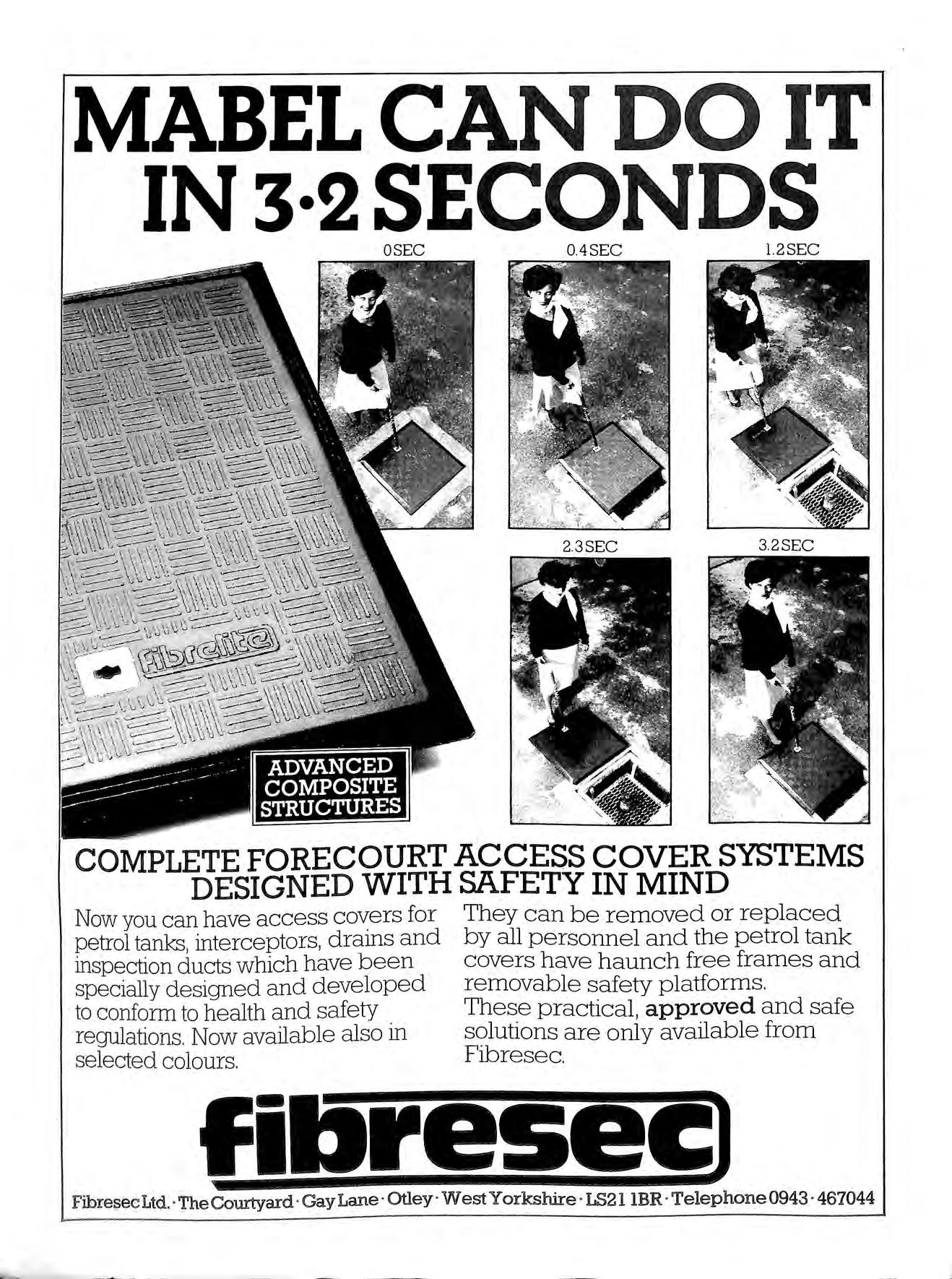
OSEC l.2SEC 2.3SEC COMPLETE FORECOURT ACCESS COVER SYSTEMS DESIGNED WITH SAFETY
MIND
MABEL CAN DO IT IN 3·2 SECONDS
IN
filiresec Fibresec Ltd.·The Courtyard ·Gay Lane ·Otley· West Yorkshire· LS2 l lBR ·Telephone0943 ·467044
you can have access covers for petrol tanks, interceptors, drains and inspection ducts which have been specially designed and developed to conform to health and safety regulations. Now available also in selected colours. They can be removed or replaced by all personnel and the petrol tank covers have haunch free frames and removable safety platforms. These practical, approved and safe solutions are only available from Fibresec.

OIL POLLUTION CONTROL Rapid Response Units on call 24 hours a day for Land or Water Borne incidents. 24 HOUR EMERGENCY 1······.·············u·ri•·xt TEL: 01-8051856 DEWCO 'PROTECTING THE ENVIRONMENT' FOR DETAILS OF THIS AND OTHER OIL RELATED SERVICES: Contact : Sal es and Ma rk et ing Departm ent , DE WCO SERVICES LI M ITED, HERTFORD RO A D, ENFIELD WASH, M IDDLESEX, TELEPHONE: 01 804 1095
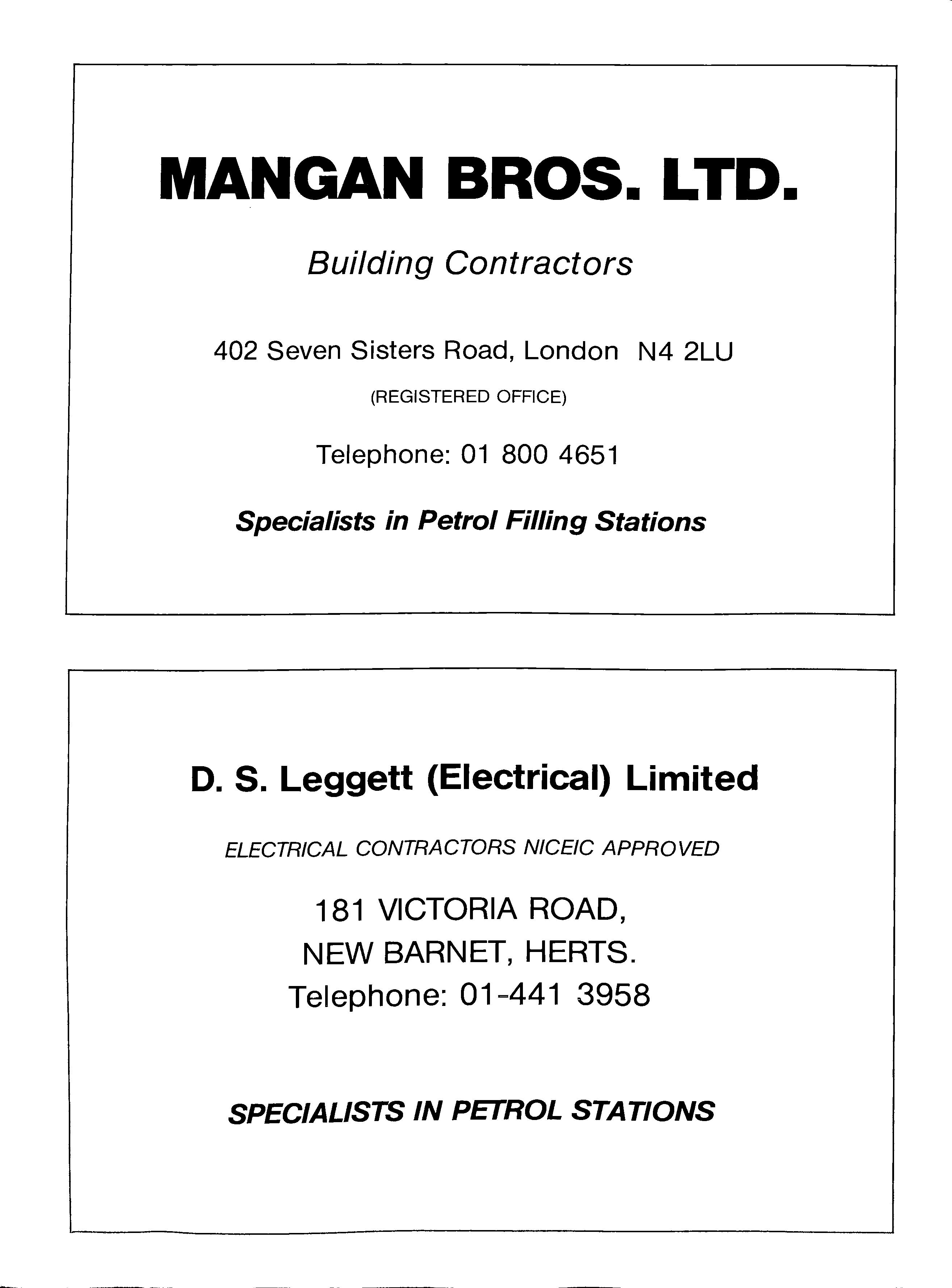
MANGAN BROS. LTD. Building Contractors 402 Seven Sisters Road, London N4 2LU (REGISTERED OFFICE) Telephone: 01 800 4651 Specialists in Petrol Filling Stations D. S. Leggett (Electrical) Limited ELECTRICAL CONTRACTORS NICEIC APPROVED 181 VICTORIA ROAD, NEW BARNET, HERTS. Telephone: 01-441 3958 SPECIALISTS IN PETROL STATIONS
Once floated on the oil/water surface the bucket filter allows oil into the col-' lection chamber by gravity feed. Water cannot pass through the filter and therefore only water free, reusable or resalable oil is collected Thus savin9 on expensive tanker cleaning , and .the possibility of oil overspill into neighbouring watercourses.

Also available:
Surface Samplers for keeping a check on quantity of oil in interceptor. For 011 spill recovery larger automatic oil skimmers and absorbent materials are available.
For automatic recovery of light oils from ground water pollutions WATER TABLE DEPRESSION OIL WATER SEPA RATI O N The Scavenger recovers oil WATER-FREE and suitable for re-sale or re-use. Scavenger is intrinsically safe and its portability enables it to be used on a site to site basis. THE SCAVENGER BUCKET FOR INTERCEPTOR OIL REMOVAL
SCAVENGER OIL RECOVERY
Side view of oily water sump:
FURMANITE ® WATER Empty filter bucket is placed in sump WATER Filter bucket is half full with oil. Filter bucket is completely ·· full and alarm signals Unit ready to be emptied Furmanite Engineering Limited Furman House, Shap Road , Kendal , Cumbria LA9 6RU Tel : (0539) 29009 Ti x 65262
For further information contact:

W. LAMB LTD. THE PREMIER PUMP AND TANK COMPANY Forecourt and Commercial - Above and Below Ground Supply Test Exchange - Service - lnstal Product Transfer De-Watering - Removal - Purchase Tank Demolition Removal Safety Filling Large Stocks of New and Secondhand Petrol and Diesel Pumps , Tanks and Accessories DAYBROOK STREET, SHERWOOD, NOTTINGHAM 0602 621511 + 608084 TRINITY WORKS, BOURNE END LANE, HEMEL HEMPSTEAD 0442 772296 Telephone 021-236 0347 W. J. FJNCH (Installations) Ltd. Steaming out and de-gassing petrol tanks; issuing gas free certificates Complete petrol and fuel oil bulk storage tank installations Petrol and fuel oil tank cleaning service Pressure testing tanks and pipe work Heaton House, Camden St., Birmin g ham BI 3BZ
HUMBERSIDE BRANCH
R. G. Kitching Humberside County Council,
EASTERN BRANCH
Honorary Secretary: Mr. B. D. Taylor, Cambridgeshire County Council
Talking Point
This issue shows dramatically the problems that can arise on petrol filling stations and demonstrates the continued need for the Oil Industry and Petrol Licencing Authority to work together to prevent re-occurance. Since the Home Office relinquished petroleum responsibility to the in 1974 no longer kept on fires or accidents at petrol filhng stat10ns, and these problems are no longer highlighted to the Industry or Central Government. . The H.S.E. should consider seriously the collection of statistics on petrol leaks, spillages, overfill.sand fires at petrol filling stations; this w!ll .enable .the as a whole to direct its resources m improvmg pubhc safety.
BRANCH
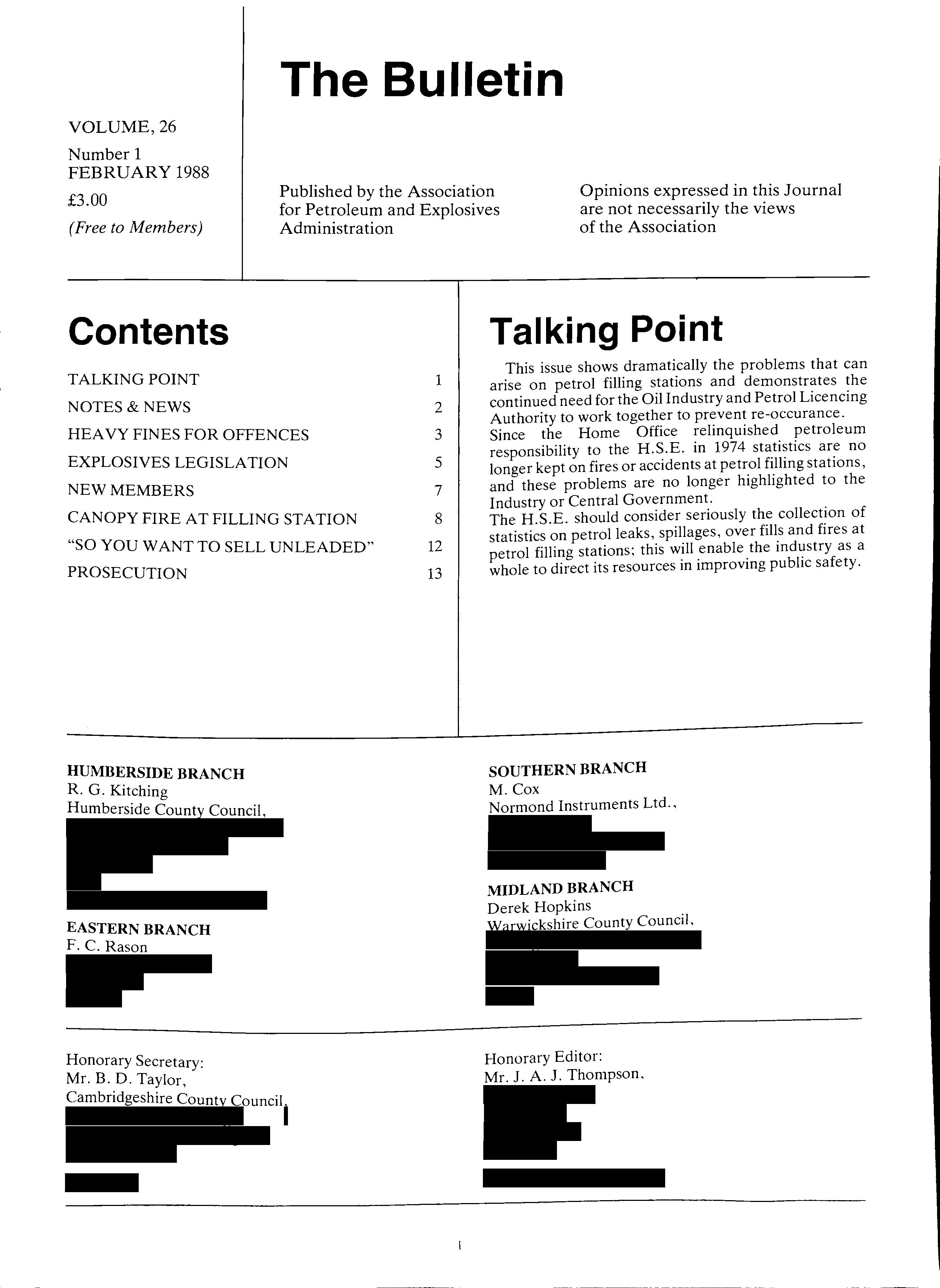
Bulletin
(Free
The
VOLUME,26 Number 1 FEBRUARY 1988 £3.00
to Members) Published by the Association for Petroleum and Explosives Administration
Contents TALKING
NOTES&NEWS HEAVY FINES FOR OFFENCES EXPLOSIVES LEGISLATION NEW MEMBERS CANOPY FIRE AT FILLING STA TI ON "SO YOU WANT TO SELL UNLEADED" PROSECUTION
Opinions expressed in this Journal are not necessarily the views of the Association
POINT
F. C. Rason
1 2 3 5 7 8 12 13
SOUTHERN
M.Cox Normand Instruments Ltd., MIDLAND BRANCH Derek Hopkins Warwickshire County Council,
Honorary Editor: Mr. J. A. J. Thompson,
notes and news
DIARY DATES
The AGM of the Association will be held at Dunstable on 12 APRIL 1988
The Annual Petroleum Seminar will also be held at Dunstable on 27 September 1988 more infomation c a n be obtained from the Hon Secretary.
ANNUAL SUBSCRIPTIONS
The Treasurer is reminding members to pay their Annual Subcription of £14.00 which was due on January lst.
DOWN MEMORY LANE
The Association is hoping to publish photographs or papers on old, or unnusual installations or equipment which may not be in regular use , but is of historical or other interest to members. All contributions to the Editor please
ESSO PETROLEUM TAKES THE INITIATIVE TO IMPROVE ROAD TANKER DELIVERIES
During the first half of 1988 Essa will be carrying out a programme of practical "safe delivery " demonstrations providing an opportunity for all their Retailers to observe and participate in the bas ic disciplines of the "Conveyance by Road " Regulations to gain a first-hand exposure to the key ri sk areas, the role of th e Competent Person and the essential responses to emergency situations what to do "If"
In previous years, as a mater of rountine, all Essa Service Stations have reci eve d bi-annual reminders of the joint responsibilitie s (the Petroleum Licencee , the Component Person and the Tanker Driver) with Guidelines issued covering the basic steps for ensuring safe deliveries of petrolium product. Essa have e mphasised that all concerned in receiving product have a duty of care to everyone themse lve s, motorists, pedestrian s, neighbours and their employees. Nevertheless, the old adage of "familiarity" needs a jolt from time to time , and a jolt which is preventative rather than th e more painful experience of shuttin g the stable doors
This initi at ive therefore is aimed at involving all parties to participate , on a programme which is based on local service station venues and which will include a follow-up programme of encouraging each Retailer to o rganise their own demon stration for indi vidual serv ice station e mploye es.
The initial programme will involve over 200 practical in which sma ll groups of Retailers will JO!n with Retail Sales and Marketing Operations personnel , in addition to which th e Lo ca l Authority Petroleum Officers will a lso be invited to participate as obs_erver s. Esso will be taking ste ps to m a ke contact with mdividual Petroleum Officers around th e country _them to attend _ recognising that their contrib uti o ns and e ndorsement will be a significant part of t hi s programme .
T he Associatio n welcomes this programme and would as k a ll petroleum officers to ass ist where they ca n .
SYD WORSFORD. OBITUARY
The Association learnt, with regret, of the death of a former Chairman of the Association Syd Worsfold on 19 December. Syd was a well known petroleum officer of many years standing and worked in London with the LCC and the GLC. He served as Chairman during 1980 and chaired the first APEA seminar on the 1981 Conveyance Regulations. He will be remembered by m a ny for his lively lecture courses which were run at Nottingham for man y years. Syd retired as a petroleum in sp ec tor in London in 1985 , following retirement h e carried out some co nsultancy work with Ultramar. The Assoc ia tion extends its deep est sympathy to his widow and two children on their los s

2
A CHANGE FOR THE BETTER
This is the 30th year of the Association. To the Council earlier in the year it certainly seemed a good time to take stock. Was the Association in the best possible shape for the future? It is very definately thriving, the membership continues to grow, the Association meeting are well attended. The finances are sound. However this very increase in the Association size and interest brings its own problems. The Association is what is known in law as an "unincorporated association" The law about such bodies is in some areas, rather grey. In particular the liability of members in the event of say some claim being made against the Association is a matter of concern. Earlier in the year the Council took legal advice and at the AGM in April will propose that the legal bars of the Association be changed. A new private company limited by guarantee is proposed which will form a sound foundation for the Association. Coupled with this change the rules by which the Association is run will be updated and more clearly set out. The objectives and aims will remain the unchanged and none of the features you are used to will alter. In one respect the Council does which to recommend a change. That is in respect or members who are a corporate body or local authority. It is unclear from the rules who is entitled to vote and what benefits are available. A new class of membership is proposed, that of corporate member, with the duty for a member of that class to appoint a representative to vote.
Full details of the proposed change will be sent with the AGM paper. Incidentally under the proposed arrangements the liabiltity of members will be limited to £1.
A F Levett, Chairman
POSTERS AND POCKET CARDS PUBLISHED ON SAFE USE OF PETROL
Clear and easy to read posters and pocket cards encouraging the safe use of petrol by garage employees and by mobile workers employed away from their home base have been published by the Health and Safty Executive.
They have been printed to make everyone involved in the handling of petrol familier with the risks of this highly flammable and hazardous product and the precautions they need to take when dealing with it. Most of the 100 or so incidents involving petrol which happen every year cause injury and there are fatalities.
The basic precautions which should be taken when handling petrol are to keep it in a secure, labelled container in a safe place with a proper procedure for its use.
Draining of petrol from vehicles should be done in a well ventilated place, preferably outside and never over a pit. Ignition sources, especially hand lamps and power tools, should be kept well away and precautions against splashing should be taken.
Hot work on petrol tanks is potentially highly dangerous and should be left to experts. Detailed advice is contained in HSE Guidance Note CS15, 'The cleaning and gas freeing of tanks containing flammable residues'.
Mobile workers should carry petrol only in suitable containers kept in a safe place away from sources of ignition. Items such as lawnmowers and chainsaws should be refuelled after being allowed to cool off using a funnel or pouring spout with the engine turned off. Any spillage should be promptly cleaned up.
The set contains two posters and two pocket cards and has been widely distributed to a number of organisations and establishments, including garages, local authorities,unions and the petroleum industry.
KF7 FOR INFILLING OF DISUSED PETROL TANKS
The object in the filling of disused petrol tanks is to exclude air and petrol vapour so obviating the danger of explosion/fire.
The requirement therefore is for a low-cost, non-shrink filler with a minimum strength capable of placement by pouring from any standard grout mixer, and which will on setting and hardening assimilate all the mix water so that no space is left for vapours to accumulate.
Pozament KF7 is such a material. When set it is slightly flexible and non-shrink.
It is mixed in water in any standard grout mixer and can be tip poured or pumped at a water solids ratio of 5 parts water to 1 part powder by weight. It thus requires only 191 Kg (392 lbs) of powder to produce lm3 of set material. It has no deletrious effect on steel.
It is available in waterproof bags (25Kg).
It offers suitable inexpensive alternative to concrete and can be mixed or paced on site by unskilled labour and a minimum of supervision.
DATA Mix per cu.m.
191 Kgs KF7 powder (392 lbs) 955 Kg water (1958 pounds196 gallons)
Strenght (comprressive) 1 day 0.17 N/mm2 14day 0.25 N/mm2 90 day 0.50 N/mm2
Deliveries can be arranged by contacting: Sales Office Manager Pozament Ltd
PETROLEUM MEASUREMENT MANUAL
Part VI Section 2 . . . f Pipelines Guide to Automatic Sampling of Liqmds rom t' "t 1 · measurement ac 1v1 y Automatic pipelme samp mg is a · d third that is still being developed. This completely form edition of Part VI Section 2 has bee_n bout the of a guide in order to give useful mformatI?n :hat there present state of developm;nt as yet no are still some .or w ic . dited information definite an wers. This Gmde contams e et from a r umber of different sources, some YIP unpublisht. d. It to be as Automatic Sampling Panel can e ' ' . . a aratus and better theories contmue to appeai. It is that it will povide a foundation on which further developments can be built.
The major source of information for this draft ISO 3171 'Petroleum Liquids-Autom?t1c Sampling' to which there were .a number of contributions including those of the IP. Much mformation was deri\ed from the IP Petroleum Standards, Chapter 8 Sampling, Section 2 - Automatic Sampling of Petroleum and Petrol Products.
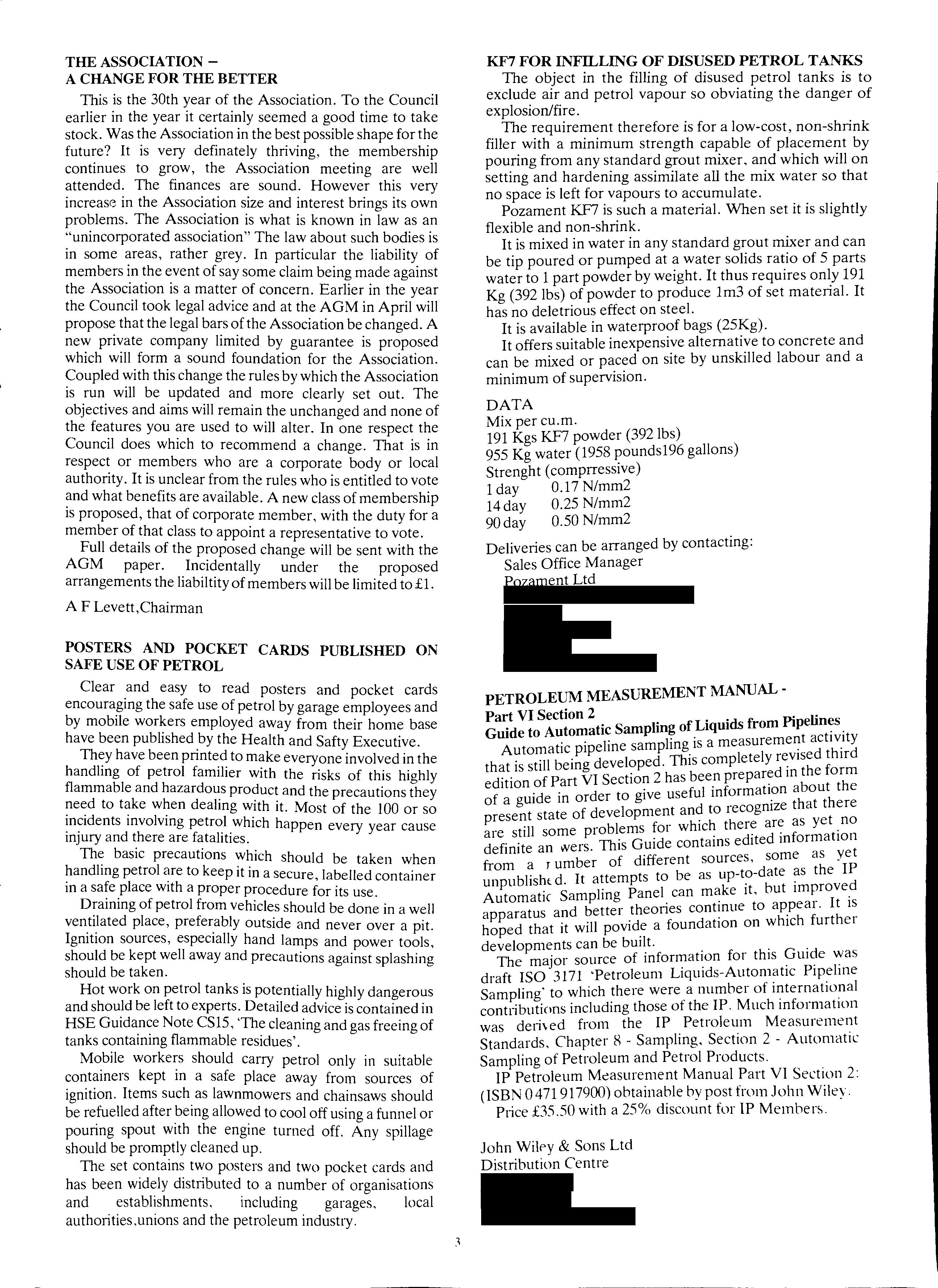
,
IP Petroleum Measurement Manual Part VI Section 2: (ISBN 0471917900) obtainable by post from John Wiley. Price £35.50 with a 25% discount for IP Members.
John Wilt>y & Sons Ltd Distribution Centre
THE ASSOCIATION
Heavy Fines for Petrol Storage Offences
PROPRIETORS of the Thorpe Service Station on Richardshaw Lane, Pudsey, were fined more than £6,000 between them by magistrates after admitting a string of offence connected with petrol storage.
Roger Butterfield, of West Yorkshire Fire Authority, told the court some of the offences could have led to petrol spillage and dangerous vapours escaping.
But he said since the premises were first inspected all the defects had been rectified.
Yakub Yusuf Patel, 29, Ahmed Yusuf Patel, 45, and Yunus Yusuf Patel, 39, all of Savile Road, Dewsbury, pleaded guilty to 12 charges.
Andrew Dallas, defending, said a major problem for his clients had been delegation.
They relied heavily on subcontracters with the necessary skills tokeep the premises up to the required standard.
And he said the licencing regulations were complicated and covered 25 pages. "THere are many pitfalls for operators of garages to fall into," he told the court.
The Patels were fined a total af £2, 150 each and ordered to pay £86,66 costs.
The details are as follows.
1. That on Tuesday 16 June 1987 at Thorpe Service Station, Richardshaw Lane, Pudsey, Leeds you did fail to comply with Conditions of Part V Section 23 in that you did not keep the filling and dipping pipe of Tank No 1 securely locked.
Contrary to S1(3)
Petroleum (Consolidation) Act 1928. Fine £2200
2. That on Tuesday 16 June 1987 at Thorpe Service Station, Richardshaw Lane, Pudsey, Leeds you did fail to comply with Conditions of Licence Part V Section 23 in that you did not keep the filling and dipping pipe of tank No 2 securely locked.
Contrary to S1(3)
Petroleum (Consolidation) Act 1928. Fine £200
3. That on Tuesday 16 June 1987 at Thorpe Service Station, Richardshaw Lane, Pudsey, Leeds you did fail to comply with Conditions of Licence Part V Section 23 inthat you did not keep the filling and dipping pipe of Tank No 3 securely locked.
Contrary to S1(3)
Petroleum (Consolidation) Act 1928. Fine £200
4. That on Tuesday 16 June 1987 at Thorpe Service Station, Richardshaw Lane, Pudsey , Leeds you did fail to comply with Condition of Licence Part V Section 7a in that you did not ensure the dipstick for Tank No 3 is of non-ferrous material.
Contrary to S1(3)
Petroleum (Consolidation) Act 1928. Fine £300
5. on Tuesday 16 June 1987 at Thorpe Service Station, Richardshaw Lane, Pudsey, Leeds being the occupier to whom a Licence has been granted under the Petroleum (Consolidation) Act 1928 you did fail comply with Condition of Licence Part V Section 12 m that there was a collecting space for petroleum spirit or vapour beneath Pump No 2.
Contrary to 1(3)
Petroleum (Consolidation) Act 1928. Fine £300
6. on l_'uesday 16 June 1987 at Thorpe Service Statio?, R1chardshaw Lane, Pudsey, Leeds being the occupier to whom a Licence has been granted under the (Consolidation) Act 1928 you d!d fail to comply with Condition of Licence Part V Section 12
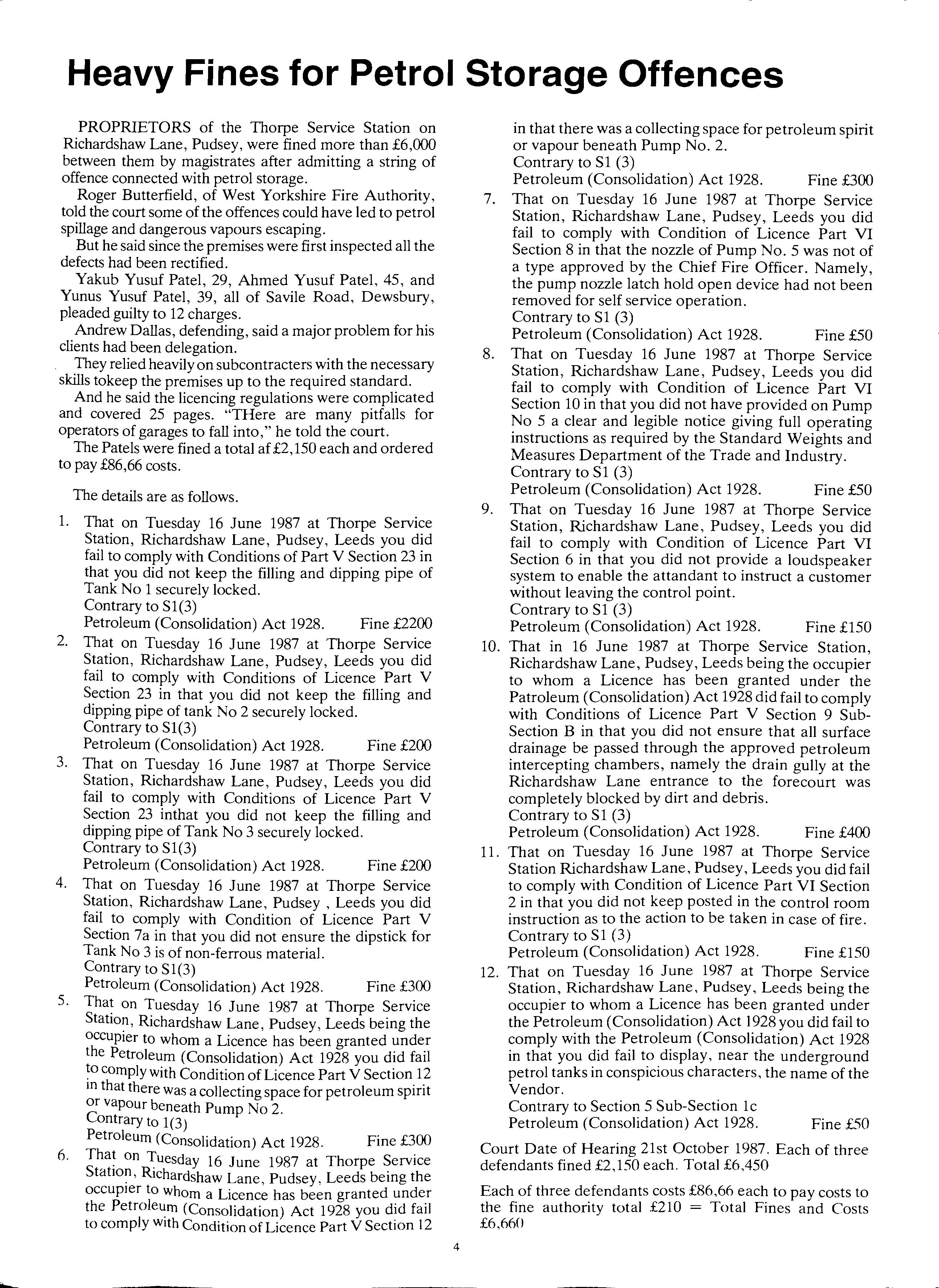
in that there was a collecting space for petroleum spirit or vapour beneath Pump No. 2.
Contrary to Sl (3) Petroleum (Consolidation) Act 1928. Fine £300
7. That on Tuesday 16 June 1987 at Thorpe Service Station, Richardshaw Lane, Pudsey, Leeds you did fail to comply with Condition of Licence Part VI Section 8 in that the nozzle of Pump No. 5 was not of a type approved by the Chief Fire Officer. Namely, the pump nozzle latch hold open device had not been removed for self service operation.
Contrary to Sl (3) Petroleum (Consolidation) Act 1928. Fine £50
8. That on Tuesday 16 June 1987 at Thorpe Service Station, Richardshaw Lane, Pudsey, Leeds you did fail to comply with Condition of Licence Part VI Section 10 in that you did not have provided on Pump No 5 a clear and legible notice giving full operating instructions as required by the Standard Weights and Measures Department of the Trade and Industry.
Contrary to Sl (3) Petroleum (Consolidation) Act 1928. Fine £50
9. That on Tuesday 16 June 1987 at Thorpe Service Station, Richardshaw Lane, Pudsey, Leeds you did fail to comply with Condition of Licence Part VI Section 6 in that you did not provide a loudspeaker system to enable the attandant to instruct a customer without leaving the control point.
Contrary to Sl (3) Petroleum (Consolidation) Act 1928. Fine £150
10. That in 16 June 1987 at Thorpe Service Station, Richardshaw Lane, Pudsey, Leeds being the occupier to whom a Licence has been granted under the Patroleum (Consolidation) Act 1928 did fail to comply with Conditions of Licence Part V Section 9 SubSection B in that you did not ensure that all surface drainage be passed through the approved petroleum intercepting chambers, namely the drain gully at the Richardshaw Lane entrance to the forecourt was completely blocked by dirt and debris.
Contrary to Sl (3) Petroleum (Consolidation) Act 1928. Fine £400
11. That on Tuesday 16 June 1987 at Thorpe Service Station Richardshaw Lane, Pudsey, Leeds you did fail to comply with Condition of Licence Part VI Section 2 in that you did not keep posted in the control room instruction as to the action to be taken in case of fire.
Contrary to S 1 (3) Petroleum (Consolidation) Act 1928. Fine £150
12. That on Tuesday 16 June 1987 at Thorpe Service Station, Richardshaw Lane, Pudsey, Leeds being the occupier to whom a Licence has been granted under the Petroleum (Consolidation) Act 1928 you did fail to comply with the Petroleum (Consolidation) Act 1928 in that you did fail to display, near the underground petrol tanks in conspicious characters, the name of the Vendor.
Contrary to Section 5 Sub-Section le Petroleum (Consolidation) Act 1928. Fine £50
Court Date of Hearing 21st October 1987. Each of three defendants fined £2, 150 each. Total £6,450
Each of three defendants costs £86,66 each to pay costs to the fine authority total £210 = Total Fines and Costs £6,660
4
Explosive Legislation
B.D. Taylor
Cambridgeshire County Council
1. The Explosive Act 1875 General
The Explosive Act, 1875 control the manufacture, keeping, sale, conveyance and importation of explosives. In order to adapt the Act to the wide explosives are now used, many Orders in Council and Orders of the Secretary of State have been made. An exhaustive study of all the requirements of the Act and Orders is not within the scope of this paper; nevertheless, as the Act is largely administered by the local authority, an understanding and appreciation of the legislation as it affects the local authority and their officers may prove valuable.
2. Application and Definition
(a) Application Section 3 - The Act applies to 2 and other explosives.
(b) Definition Section 3 - The term "explosive" means:
Gunpowder Gun cotton Coloured fires
Ammunition Nitro-glycerine
Blasting powders
Fog signals
Fulminates (Mercury et cet) Dynamite Fuses Fireworks
The term "explosive" in this Act applies to the items listed above and to every other substance used or manufactured with a view to producing a practical effect by explosive or a pyrotechnic effect. A full list of Authorised Explosive is published each year by the Health and Safety Executive (HMSO).
(c) Explosives Classes- Order in Council No.1 Explosive are divided into seven "Classes". These classes incertain cases are sud-divided into seven "Classes". These classes in certain cases aare subdivided into "Divisions":
(1) Gunpowder class
(2) Nitrate mixture class
(3) Nitro-compound class
(4) Chlorate mixture class
(5) Fulminate class
(6) Ammunition class
(7) Firework class
3. Administration
For the purposes of administration the Act is conveniently divided into four parts, each part applying to an occupational group.
Sect!ons 6-14: Factories and Magazines
Sections 15-20: Consumer' Stores for Explosives (60lbs 4000lbs)
Sect!ons 21-22 Retail Dealing with Explosives (i.e. Premises)(not exceeding 60lbs)
Sections 5, 41, 50: Keeping for Private Use (UPto lOlbs)
In a??ition, there is legislation governing specific conditions and occupations such as: Harbour bylaws
Canal bylaws
Conveyance by Road
Exemption Section 97
The Act does not apply to any factory, magazine, store
os explosive under the control of any government department.
4. Licencing, Registering, Certifying and Inspecting
(1) Factories and Magazines.
(i) For a new factory or magazine, a draft licence and plan must be submitted by the applicant to the Health and Safety Executive. After the approvalof the Health and Safety Executive has been obtained, the assent of the local authority is required. The licence is finally confirmed by the Health and Safety Executive.
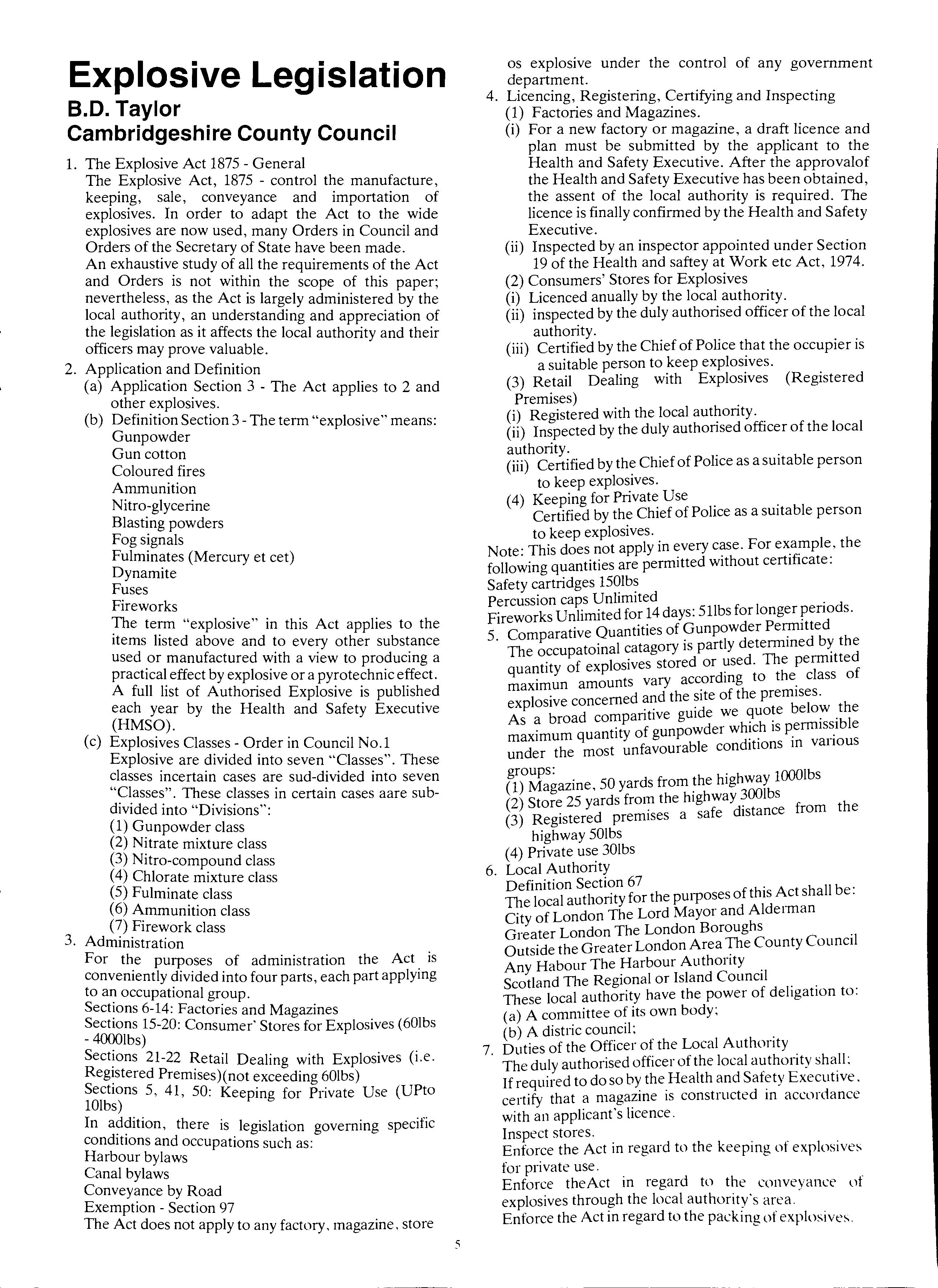
(ii) Inspected by an inspector appointed under Section 19 of the Health and saftey at Work etc Act, 1974.
(2) Consumers' Stores for Explosives
(i) Licenced anually by the local authority.
(ii) inspected by the duly authorised officer of the local authority.
(iii) Certified by the Chief of Police the occupier is a suitable person to keep explosives.
(3) Retail Dealing with Explosives (Registered Premises)
(i) Registered with the local authonty.
(ii) Inspected by the duly authorised officer of the local authority. . . (iii) Certified by the Chief of Police as a smtable person to keep explosives.
(4) Keeping for Private Use . . Certified by the Chief of Police as a smtable person to keep explosives.
Note: This does not apply in every For the following quantities are permitted without certificate: Safety cartridges Percussion caps Unlimited Fireworks Unlimited for 14 days: 5libs forlonger penods.
5. Comparative Quantities of Gunpowder Pei:nitted
The occupatoinal catagory is partly determined the quantity of explosives stored or used. The permittedf amounts vary according to the class o maximun . . explosive concerned and the of the premises. h As a broad comparitive gmde we quote .t e maximum quantity of gunpowder is under the most unfavourable conditions m vanous
groups: h' h IOOOlbs (1) Magazine, 50 yards from the ig way (2) Store 25 yards from the highway from the (3) Registered premises a safe distance highway 50lbs (4) Private use 30lbs
6. Local Authority Definition Section 67
The local authority for the purposes of this Act shall be. City of London The Lord Mayor and Alderman Greater London The London Boroughs Outside the Greater London Area County Council Any Habour The Harbour Authonty . Scotland The Regional or Island Council These local authority have the power of dehgat10n to: (a) A committee its own body; (b) A distric council;
7. Duties of the Officer of the Local Authonty 1
The duly auth01ised officer of the local sha_ I: If required to do so by the Health and Safety Executive. certify that a magazine is constructed in accordance with an applicant's licence. Inspect stores.
Enforce the Act in regard to the keeping of explosives for private use.
Enforce theAct in regard to the conveyance uf explosives through the local authority's area. Enforce the Act in regard to the packing of explosives.
5
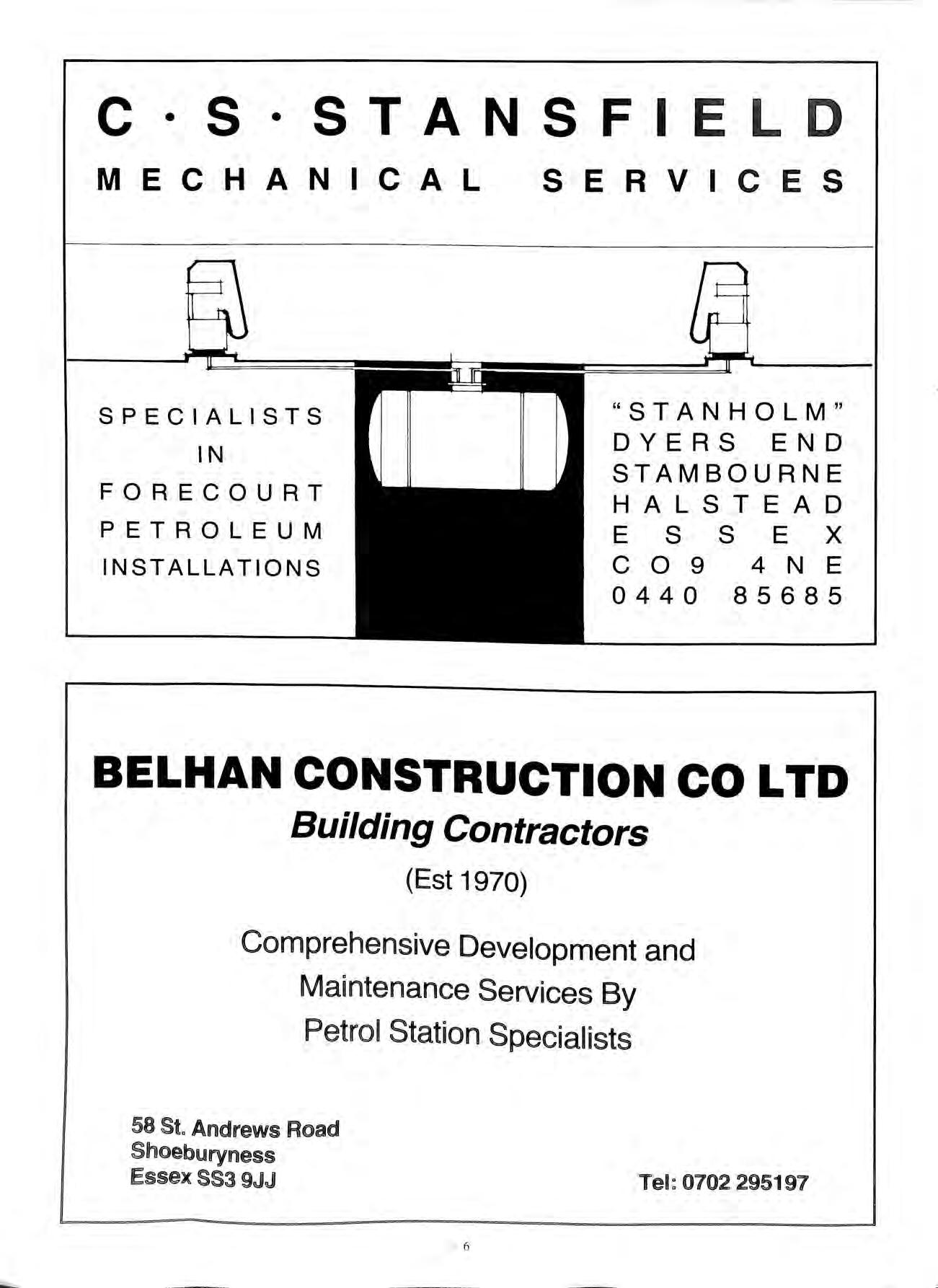
C·S·STANSFI ELD MECHANICAL SPECIALISTS IN FORECOURT PETROLEUM INSTALLATIONS SERVICES "STAN HOLM" DYERS END STAM BOURNE HALSTEAD E S S E X C 0 9 4 N E 0440 85685 BELHAN CONSTRUCTION CO LTD Building Contractors (Est 1970) Comprehensive Development and Maintenance Services By Petrol Station Specialists 58 St Andrews Road Shoeburyness Essex SS3 9JJ 6 Tel: 0702 295197
8. Right of Entry
The local authority's officer has no right of entry into premises licensed by the Health and Safety Executive (Factories and Magazines).
He has the right of entry into stores and registered premises for purposesof inspection.
9. Powers of Inspection
The powers of an inspector appointed under Section 19 of that Act.
Requirements
It is neither possible nor desirable to cover the whole field of requirements for all types of premises. Below are summaries of:
Storage requirements in registered premises for mixed explosives.
These summaries will serve to illustrate the general trend of the requirements of the Act.
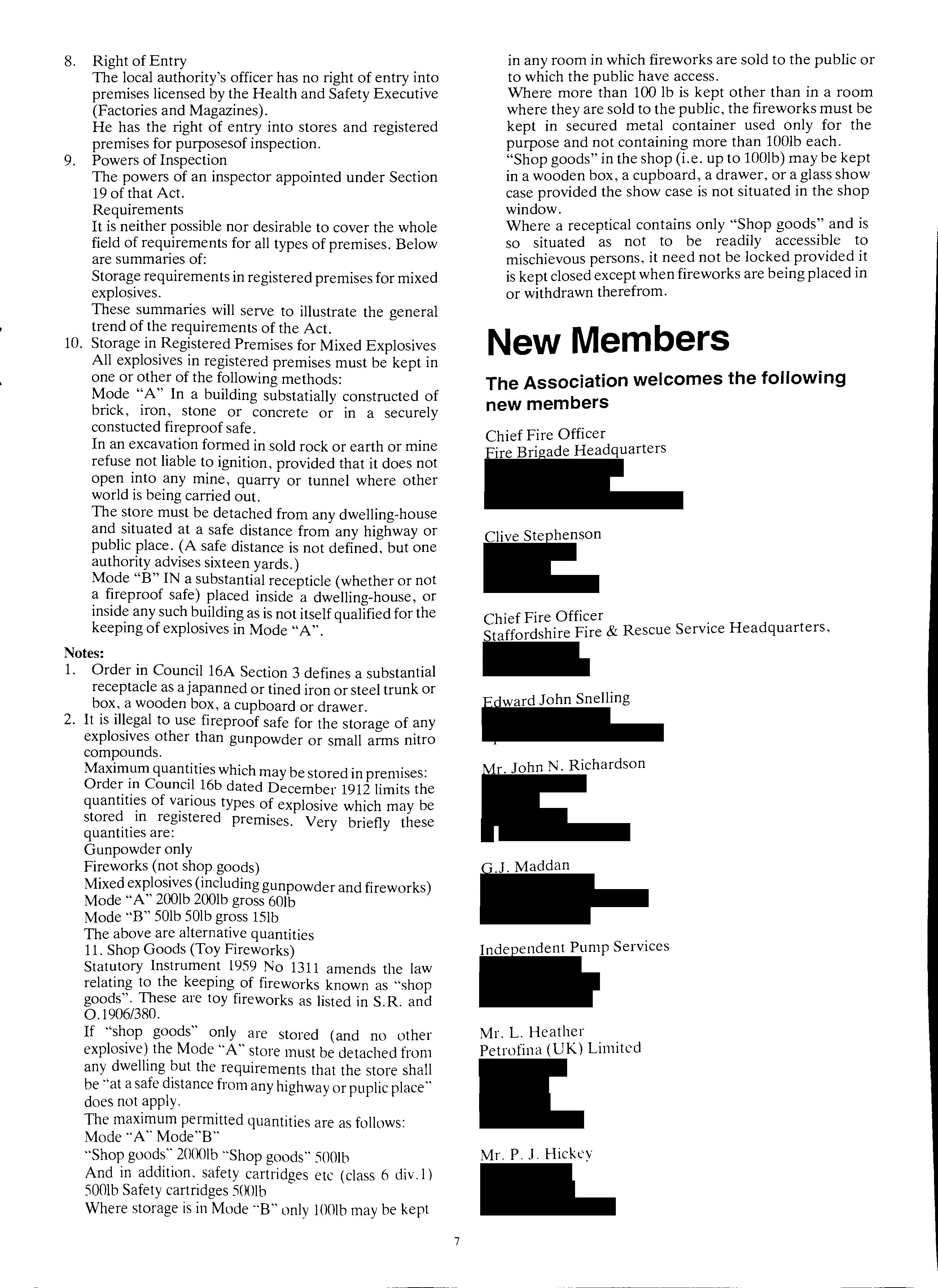
10. Storage in Registered Premises for Mixed Explosives
All explosives in registered premises must be kept in one or other of the following methods:
M?de ''.A" In a building substatially constructed of bnck, Iron, stone or concrete or in a securely constucted fireproof safe.
In an excavation formed in sold rock or earth or mine refuse not liable to ignition, provided that it does not open into any mine, quarry or tunnel where other world is being carried out.
The must be detached from any dwelling-house and at a safe distance from any highway or pubhc place. (A safe distance is not defined, but one authority advises sixteen yards.)
"B" IN a substantial recepticle (whether or not a fireproof safe) placed inside a dwelling-house, or inside any such building as is not itself qualified for the keeping of explosives in Mode "A".
Notes:
1. Order in Council 16A Section 3 defines a substantial receptacle as a japanned or tined iron or steel trunk or box, a wooden box, a cupboard or drawer.
2. It is to use fireproof safe for the storage of any explosives other than gunpowder or small arms nitro compounds.
Maxim.um which may be stored in premises: Order m Council 16b dated December 1912 limits the of types of explosive which may be . m registered premises. Very briefly these quantities are:
Gunpowder only Fireworks (not shop goods)
Mixed explosives (including gunpowder and fireworks)
Mode "A" 200Ib 200lb gross 60Ib Mode "B" 50lb 50lb gross 15Ib
The above are alternative quantities
11. Shop Goods (Toy Fireworks)
Statutory Instrument 1959 No 1311 amends the Jaw relating to the keeping of fireworks known as "shop goods". These are toy fireworks as listed in S.R. and 0 .1906/380.
If "sh_op goods" only are stored (and no other explosive) the Mode ''A" store must be detached from any dwelling but the requirements that the store shall be "at a safe distance from any highway or puplic place" does not apply.
The maximum permitted quantities are as follows: Mode ·•A" Mode "B"
"Shop goods" 2000Ib "Shop goods" 500Ib
And in addition, safety cartiidges etc (class 6 div. 1) 500lb Safety cartridges 500lb
Where storage is in Mode '"B" only lOOib may be kept
in any room in which fireworks are sold to the public or to which the public have access.
Where more than 100 lb is kept other than in a room where they are sold to the public, the fireworks must be kept in secured metal container used only for the purpose and not containing more than lOOib each.
"Shop goods" in the shop (i.e. up to lOOib) may be kept in a wooden box, a cupboard, a drawer, or a glass show case provided the show case is not situated in the shop window.
Where a receptical contains only "Shop goods" and is so situated as not to be readily accessible to mischievous persons, it need not be locked provided it is kept closed except when fireworks are being placed in or withdrawn therefrom.
New Members
7
The Association welcomes the following new members
Chief Fire Officer Fire Brigade Headquarters
Clive Stephenson
Chief Fire Officer . Staffordshire Fire & Rescue Service Headquarters,
Edward John Snelling
Mr. John N. Richardson G.J. Maddan
Independent Pump Services
Mr. L. Heather Petrofina (UK) Limited Mr. P. J. Hickey
Canopy Fire at Filling Station causes concern for public safety
A recent fire at a petrol filling station in London has highlighted a problem which could effect th e design of filling statio ns throughout the U .K.
The premise involv e d is a busy self-service si te built in East London to a modern design , standing on a main road. It has six pump s und er a large canopy , measuring 14m x 18m , a nd features the canopy design of Mobil Oil Co. , havin g circular li ghtin g units situated at each column , as illu strated on the photographs
The six ring dropp e rs have illumin at io ns thrown up to reflect light down on the filling area.
At approximately 1505 hours on Thursday 3 December 1987 , a time of quiet trade , a mobile burgerbar veh icle came o nto the si te to fill up with petrol. At first , filling appeared to be normal , but as th e auto m at ic cut-off o n the pump nozzle ope ra ted, a pool of petrol was noticed und er the veh icle by th e owne r/ driver. A s she went towards the sit e shop to comp lain about this apparent lat e cut -off , staff in sid e the shop noticed flames inside the rear of the ve hicl e. The small poo l of petrol ign ite d.
A pass in g freelance photographer , Mr. C li ve Simpso n , took a se ri es of photographs that very d e arly show th e deve lopment of the fire before the B ri gade a rri ve d As was_ to be expected , the spi lt petrol rapidly ig nit e d -; pre admg around the outside of the ve hicl e
body. However , what was mo st unexpected was th e very rapid spread along the und e rside of the caonopy. The six ring droppers and associated fixtures were clearly made of a flammable plastic material , and burning streams of molten plastic were photographed descending onto the forecourt, remote from the source, and the resulting pools of molten material continued to burn vigoroiusly.

By this time, three 15Kg cylinders in the rear of the vehicle were also involved Fortunately, r a te of heat rise was such as to allow the cylinders to vent rather than explode. The petrol pump adjacent to the vehicle was totall y destroyed by the petrol fire.
The staff behaved in accord ance with laid-down proced ure , first calling the Brigade and using emergancy switches , before tackling with the sites's portable dry powder exti nguish e rs. How eve r , the fire was clearly beyo nd control by staff at thi s point, and was extinguised by the Brigade with foam and one jet. There were no casualties , beyond a degree of shock.
Two major points arise from thi s incide nt. Firstly , the construction o f the canopy, and secondly , the ignition source .
In the original co nsent, granted by the then Greater London Co uncil under the petroleum (Consolidation) Act , the canopy was approve d , subje ct to it being co nstructed wholly of non- combust ibl e m aterials , and
I I
8
r I
with a safeguard requiring approval also by the Building Control Department of the local borough council. It appears that man)'. canop_ies of this type have been erected, within t?e U111ted Kingdom , and possibly in Europe. The main framework, soffit and roof of the canopies are properly constructed in metal.
Mobil Oil Co. Ltd. , built the the filling station that the offending material was Perspex supplied by ICI an extruded acrylic
Acrylic panels are widely used in the Oil Industry on canopy facias and lighting boxes and the amount of use depends upon the in?ividual company designs.
Extruded acrylic is flammable and will burn in the manner illustrated and is clearly unsuitable for public filling stations.
Cast acrylic is less flammable and has a class 3 rate of flame spread to BS 476 part 7.
Turning to the vehicle , it would appear that impact damage to the fuel tank had caused a degree of separation between the tank itself and the fill pipe. The gap resulting allowed a small leakage of liquid petrol and vapour
The equipment of the burger van included an LPG fuelled fridge. Although the driver of the ve hicl e was adamant that all the cylinders were shut off , one cylinder was recovered from the wreckage with regulator and a short length of flexible hose attach e d , and on removal of the melted pla stic encasing the valve group , it wa s found that the regulator wa s in th e " open " position It see ms
very likely that the pil.ot of the fridge was <?n , and that this acted as the 1g111t10n source. Recollections by the site staff of fire appearing to start within the vehicle support this theo ry.. " ,
The vehicles 1g111t1on key was found in the Off position , and as the fire damage was concentrated on the side away from the exhaust pipe, a hot exhaust has also been discounted.
Examination of the site ' s equipment , pumps and electrics generally , gave no reason at all to suspect ignition sources away from the vehicle , and no persons were smoking in or near that ar e a.
It is most fortunate that this incident took place at the time it did; it requires little imagination to visualise th e torrents of burning plastic descending onto a crowd e d forecourt , providing multiple ignition source s and possibly trapping occupants within cars.
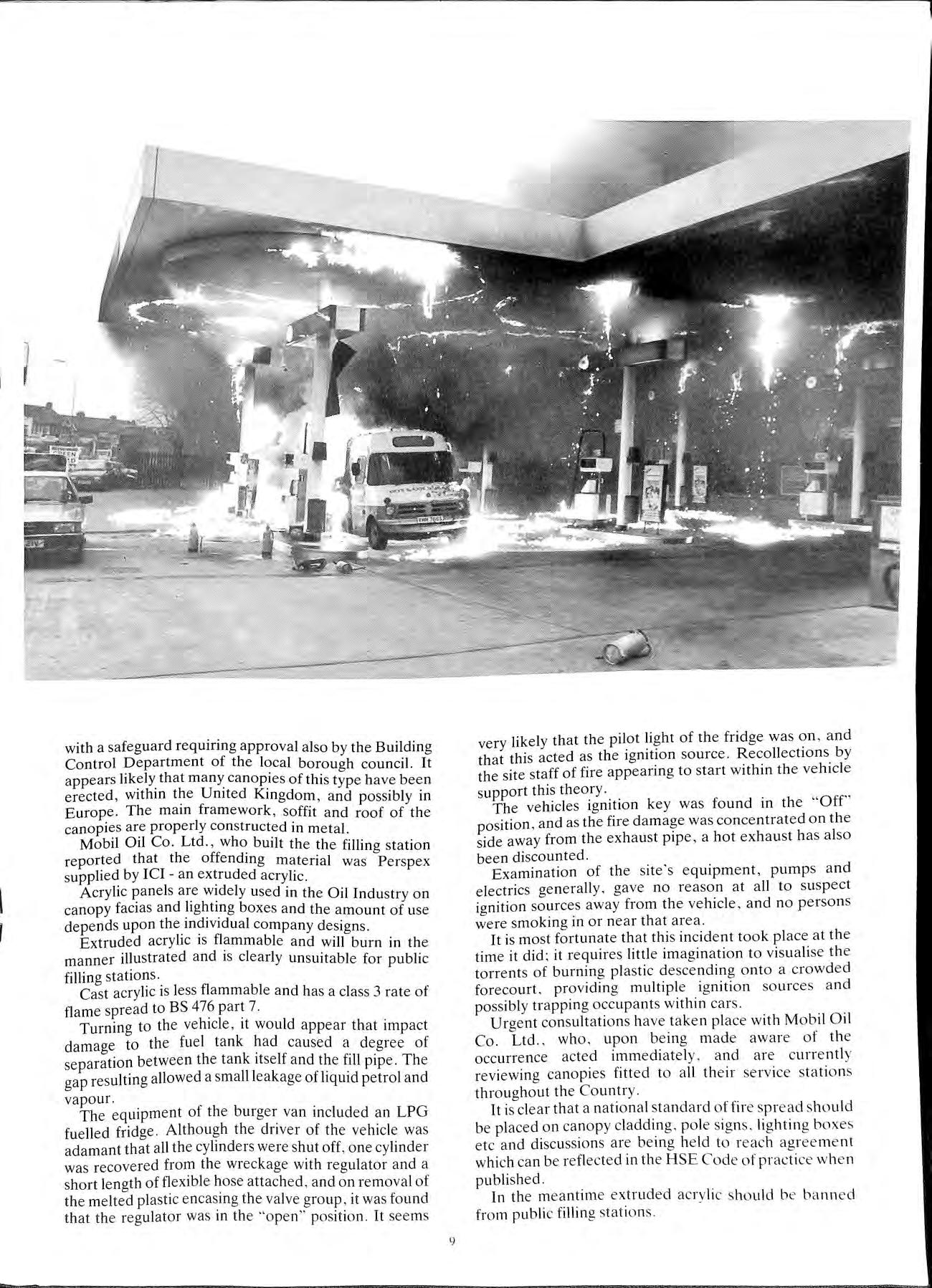
Urgent consultations have tak e n pl a ce with M o bil Oil Co. Ltd , who. upon being made awar e of the occurrence acted imm e diatel y, and are currentl y revi e wing canopi e s fitted to all th e ir service station s throughout the Countr y
It is clear that a national standard of fir e spre ad should be placed on canop y cladding . pol e sign s . lightin g b o xes etc and discussions are being held to r e ach a g r ee m e nt whi ch can be re fl ec ted in the HS E C od e of pr a cti ce wh e n published.
In the me antim e e xtrud e d a cr yli c sh o uld b e bann e d fr o m publi c filling station s .
9
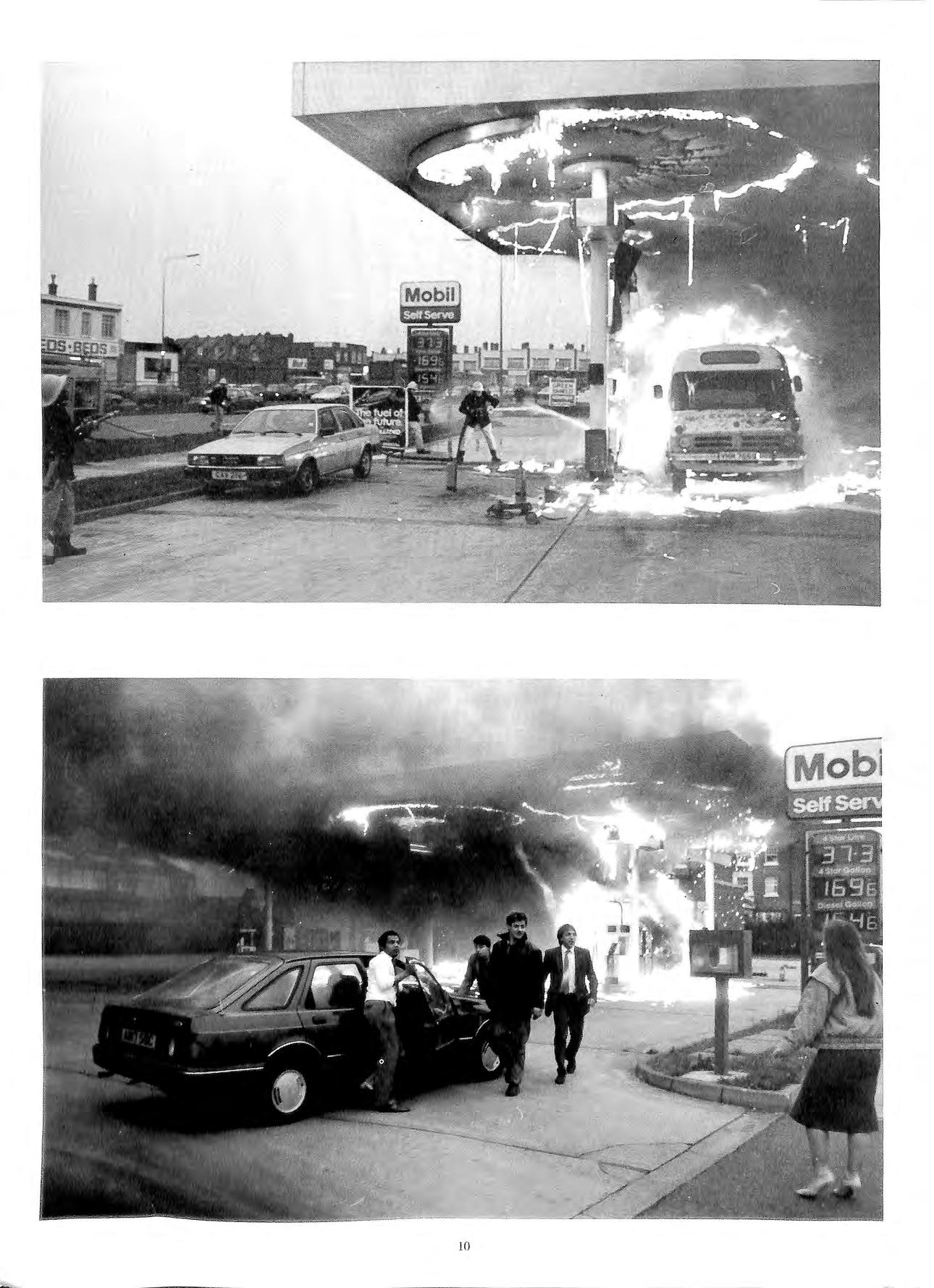
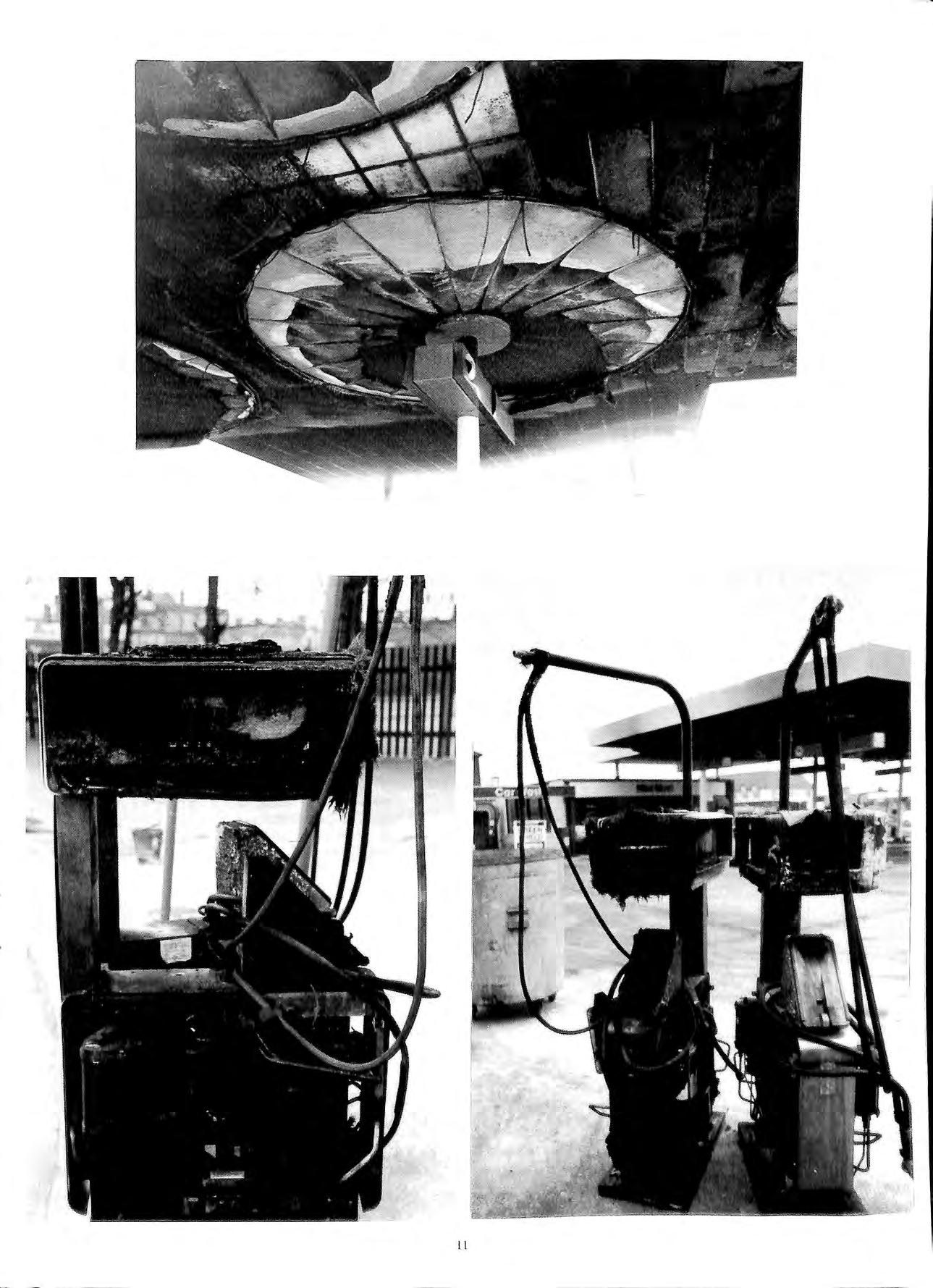
LI
"So you want to sell unleaded"
AN AIDE MEMOIRE TO ASSIST PETROL RETAILERS IN INTRODUCING UNLEADED PETROL ONTO THEIR FORECOURTS
BY CLIVE AINSLEY OF PETROL RETAILER ASSOCIATION
A)GENERAL
1. Lead Limits
The prime requirement is that at the final point of delivery to the customer the lead content of the unleaded fuel grade shall not exceed 0.013 grams/litre.
2. Road Tankers
Road tank vehicles will transport both leaded petrol and will not have dedicated compartments exclusively for unleaded. The tanker driver must NEVER put in remaining leaded petrol from other compartments, lines or hoses into a storage tank for unleaded. In the event of actual or suspected contamination of unleaded petrol the driver must report the occurrence immediately to his Depot.
The driver must advise the service station propietor (or receiver) of the occurrence and warn the receiver not to use or sell unleaded petrol from the contaminated storage tank and he must also note this action on the delivery ticket.
B) SERVICE STATIONS
l. Preparation
1.1
Tanks
Most service stations underground tanks are acceptable fo.r use with unleaded petrol if prepared in accordance with one of the two methods detailed in para 2 below.
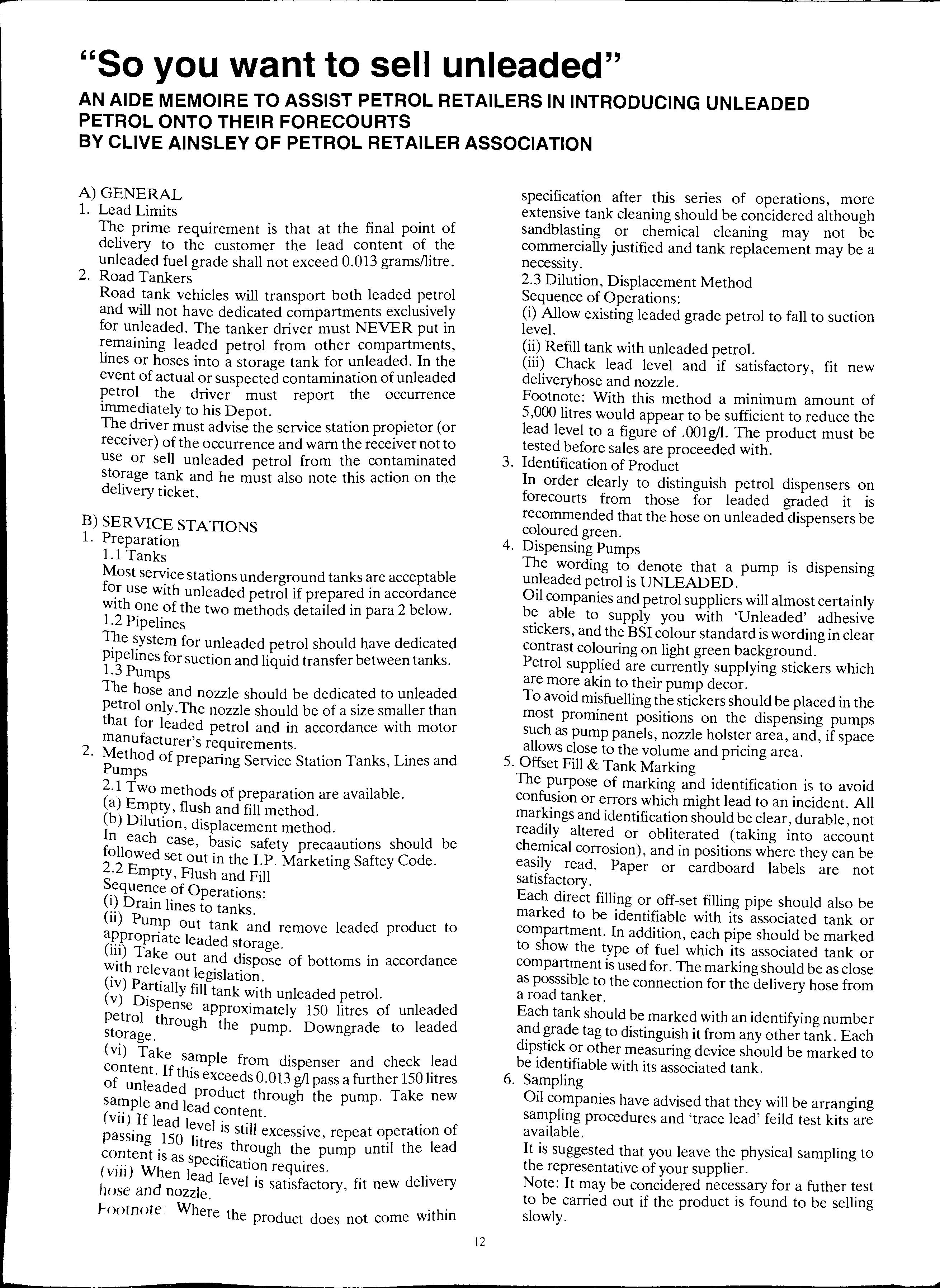
1.2 Pipelines
T_he for unleaded petrol should have dedicated pipelines for suction and liquid transfer between tanks.
1.3
Pumps
The hose and nozzle should be dedicated to unleaded petrol only.The nozzle should be of a size smaller than that for leaded petrol and in accordance with motor manufacturer's requirements.
2. Method of preparing Service Station Tanks, Lines and Pumps
2.1 Two methods of preparation are available.
(a) Empty, flush and fill method.
(b) Dilution, displacement method.
In each case, basic safety precaautions should be followed set out in the I.P. Marketing Saftey Code.
2.2 Empty, Flush and Fill s.equence of Operations: Drain lines to tanks.
(u) Pump out tank and remove leaded product to appropriate leaded storage. Take out and dispose of bottoms in accordance relevant legislation.
(iv) fill tank with unleaded petrol.
(v) Dispense approximately 150 litres of unleaded petrol through the pump. Downgrade to leaded storage.
( vi) Take sample from dispenser and check lead
If this exceeds 0.013 g/l pass a further 150 litres unleaded product through the pump. Take new and lead content.
( vn). If lead level is still excessive repeat operation of passmg 150 r ' itres through the pump until the lead content 1s as sp ·f· . . ec1 1cation reqmres.
( vm) When lead level is satisfactory fit new delivery hose and nozzle. '
Footnote• Where the product does not come within
specification after this series of operations, more extensive tank cleaning should be concidered although sandblasting or chemical cleaning may not be commercially justified and tank replacement may be a necessity.
2.3 Dilution, Displacement Method
Sequence of Operations:
(i) Allow existing leaded grade petrol to fall to suction level.
(ii) Refill tank with unleaded petrol.
(iii) Chack lead level and if satisfactory, fit new deliveryhose and nozzle.
Footnote: With this method a minimum amount of 5,000 litres would appear to be sufficient to reduce the lead level to a figure of .OOlg/l. The product must be tested before sales are proceeded with.
3. Identification of Product
In order clearly to distinguish petrol dispensers on forecourts from those for leaded graded it is recommended that the hose on unleaded dispensers be coloured green.
4. Dispensing Pumps
The wording to denote that a pump is dispensing unleaded petrol is UNLEADED.
Oil companies and petrol suppliers will almost certainly be able to supply you with 'Unleaded' adhesive stickers, and the BSI colour standard is wording in clear contrast colouring on light green background.
Petrol supplied are currently supplying stickers which are more akin to their pump decor.
To avoid misfuelling the stickers should be placed in the most prominent positions on the dispensing pumps such as pump panels, nozzle holster area, and, if space allows close to the volume and pricing area.
5. Offset Fill & Tank Marking
The purpose of marking and identification is to avoid confusion or errors which might lead to an incident. All markings and identification should be clear, durable, not readily altered or obliterated (taking into account chemical corrosion), and in positions where they can be easily read. Paper or cardboard labels are not satisfactory.
Each direct filling or off-set filling pipe should also be marked to be identifiable with its associated tank or compartment. In addition, each pipe should be marked to show the type of fuel which its associated tank or compartment is used for. The marking should be as close as posssible to the connection for the delivery hose from a road tanker.
Each tank should be marked with an identifying number and grade tag to distinguish it from any other tank. Each dipstick or other measuring device should be marked to be identifiable with its associated tank.
6. Sampling
Oil companies have advised that they will be arranging sampling procedures and 'trace lead' feild test kits are available.
It is suggested that you leave the physical sampling to the representative of your supplier.
Note: It may be concidered necessary for a futher test to be carried out if the product is found to be selling slowly.
12
TIPS FOR FORECOURT MANAGERS
1. It is recommended that your staff advise motorists to refer to the nearest known Motor Retailer or Dealer of the make of vehicle should the motorist enquire as to its use in a particular vehicle.
2. A list of such Dealers/Retailers should be made available for the forecourt staff.
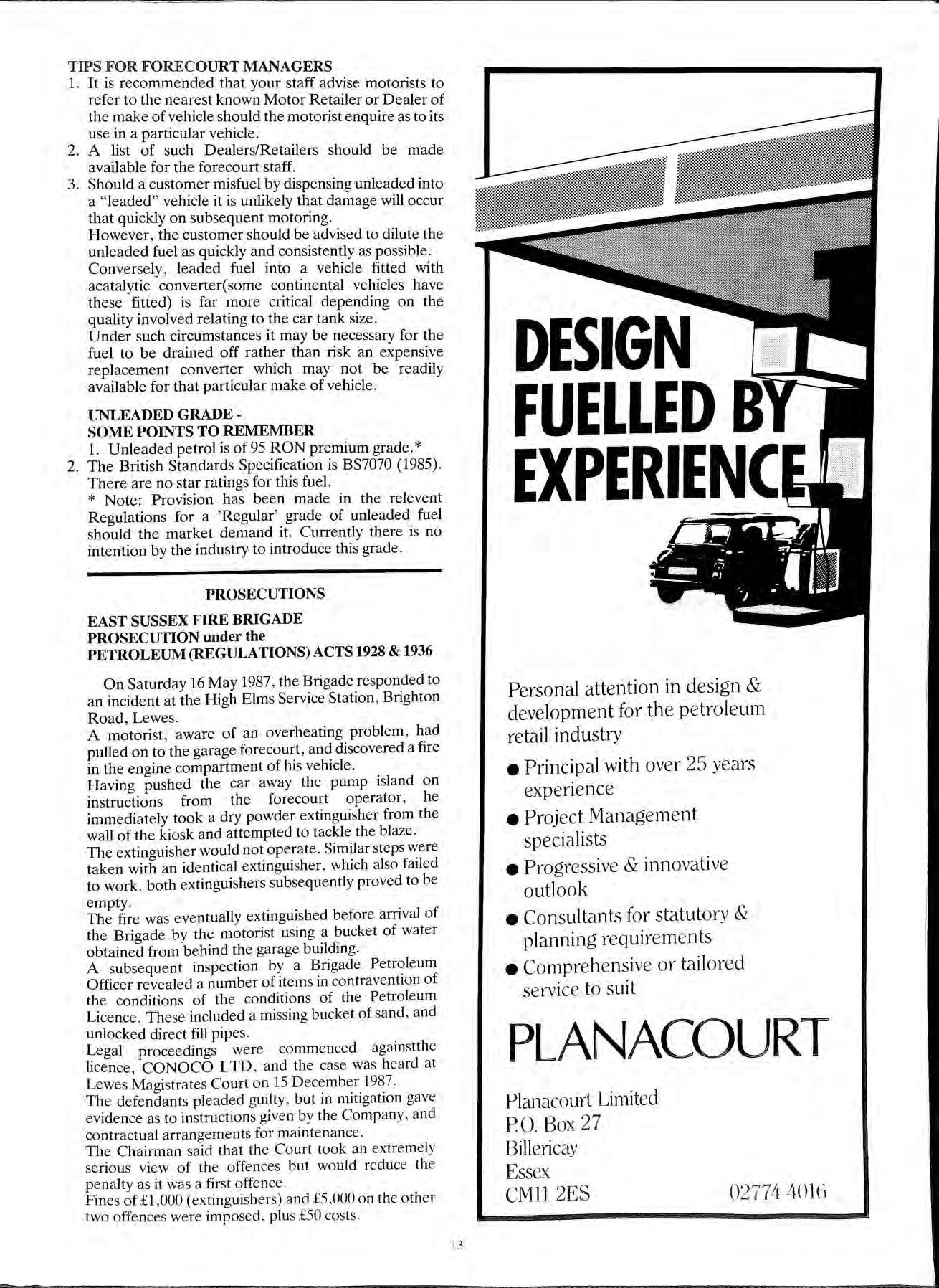
3. Should a customer misfuel by dispensing unleaded into a "leaded" vehicle it is unlikely that damage will occur that quickly on subsequent motoring. However, the customer should be advised to dilute the unleaded fuel as quickly and consistently as possible. Conversely, leaded fuel into a vehicle fitted with acatalytic converter(some continental vehicles have these fitted) is far more critical depending on the quality involved relating to the car tank size. Under such circumstances it may be necessary for the fuel to be drained off rather than risk an expensive replacement converter which may not be readily available for that particular make of vehicle.
UNLEADED GRADE SOME POINTS TO REMEMBER
1. Unleaded petrol is of 95 RON premium grade.*
2. The British Standards Specification is BS7070 (1985). There are no star ratings for this fuel.
* Note: Provision has been made in the relevent Regulations for a 'Regular' grade of unleaded fuel should the market demand it. Currently there is no intention by the industry to introduce this grade.
PROSECUTIONS
EAST SUSSEX FIRE BRIGADE PROSECUTION under the PETROLEUM (REGULATIONS) ACTS 1928 & 1936
On Saturday 16May1987, the Brigade responded to an incident at the High Elms Service Station, Brighton Road, Lewes.
A motorist, aware of an overheating problem, had pulled on to the garage forecourt, and discovered a fire in the engine compartment of his vehicle.
Having pushed the car away the pump island on instructions from the forecourt operator, he immediately took a dry powder extinguisher from the wall of the kiosk and attempted to tackle the blaze
The extinguisher would not operate. Similar steps were taken with an identical extinguisher , which also failed to work. both extinguishers subsequently proved to be empty.
The fire was eventually extinguished before arrival of the Brigade by the motorist using a bucket of water obtained from behind the garage building.
A subsequent inspection by a Brigade Petroleum Officer revealed a number of items in contravention of the conditions of the conditions of the Petroleum Licence. These included a missing bucket of sand , and unlocked direct fill pipes.
Legal proceedings were commenced againstthe licence, CONOCO LTD , and the case was heard at Lewes Magistrates Court on 15 December 1987.
The defendants pleaded guilty , but in mitigation gave evidence as to instructions given by the Company , and contractual arrangements for maintenance.
The Chairman said that the Court took an extremely serious view of the offences but would reduce the penalty as it was a first offence.
Fines of £1 ,000 (extinguishers) and £5 ,OOO on the other two offences were imposed , plus £50 costs.
l3 DESIGN FUELLED B EXPERIENC Personal attention in design & development for the petroleum retail industry e Principal with over 25 years experience • Project Management specialists e Progressive & innovative outlook •Consultants for statutory & planning requirements • Compreh e nsive or tailored service to suit PLANACOURT Planacourt Limited P.O. Box 27 Billericay Essex CMll 2ES 02774 401(1
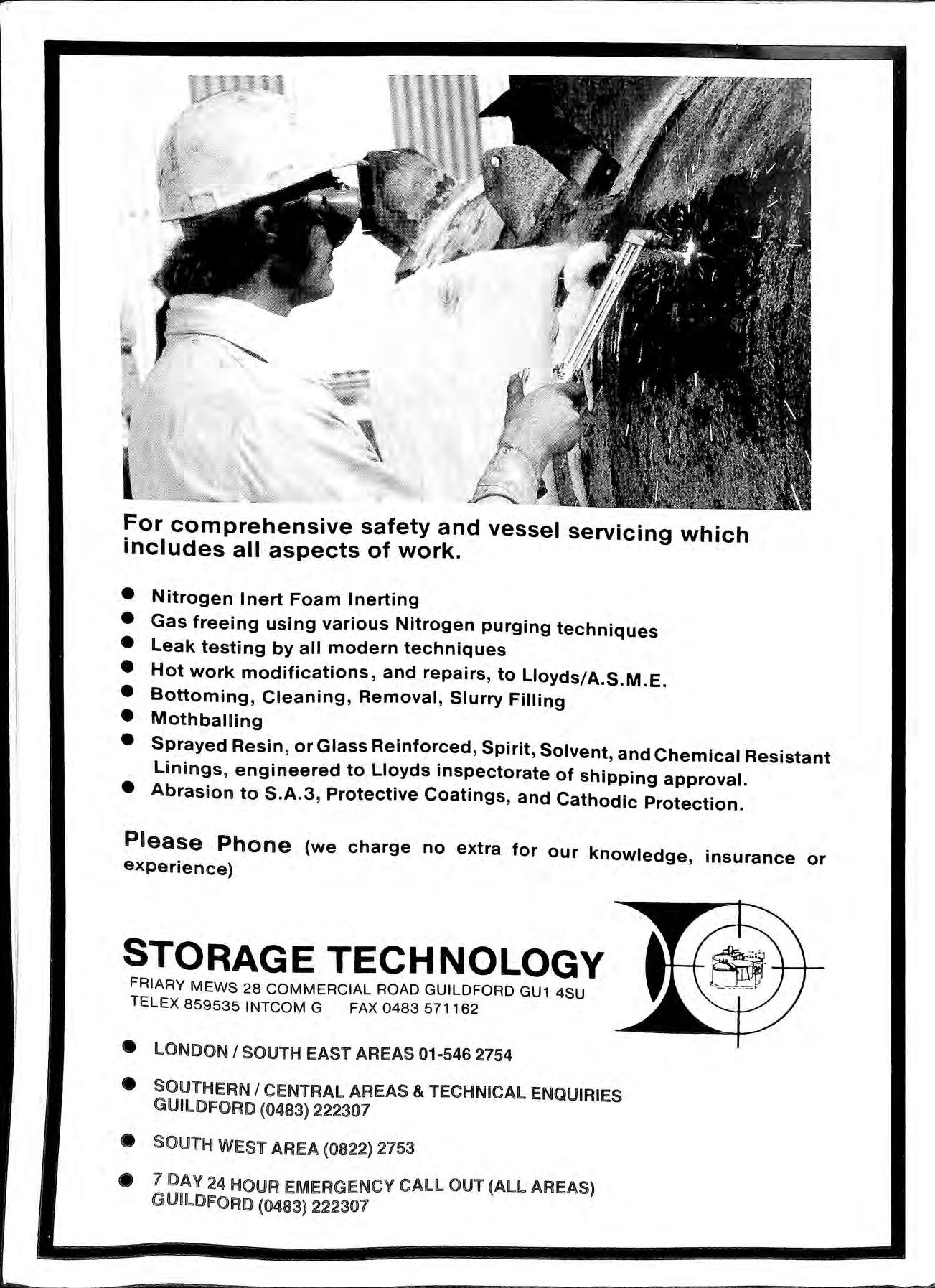
For comprehensive safety and vessel servicing which includes all aspects of work. • Nitrogen Inert Foam lnerting • Gas freeing using various Nitrogen purging techniques • Leak testing by all modern techniques • Hot work modifications, and repairs, to Lloyds/A.S.M.E. • Bottoming , Cleaning, Removal, Slurry Filling • Mothballing • Sprayed Resin , or Glass Reinforced, Spirit, Solvent, and Chemical Resistant Linings , engineered to Lloyds inspectorate of shipping approval. • Abras i on to S.A 3, Protective Coatings, and Cathodic Protection. Please Phone (we charge no extra for our knowledge, insurance or exper ie nc e ) STORAGE TECHNOLOGY FRIARY MEWS 28 COMMERCIAL ROAD GUILDFORD GU1 4SU TELEX 859535 INTCO M G FAX 0483 571162 e LONDON I SOUTH EAST AREAS 01-546 2754 e SOUTHERN I CENTRAL AREAS & TECHNICAL ENQUIRIES GrnlDFORD (0483) 222307 e SOUTH WEST AREA {0822) 2753 e 7 DAY 24 HOUR EMERGENCY CAlL OUT (All AREAS) Gl!J!LDFORD (0483) 222307
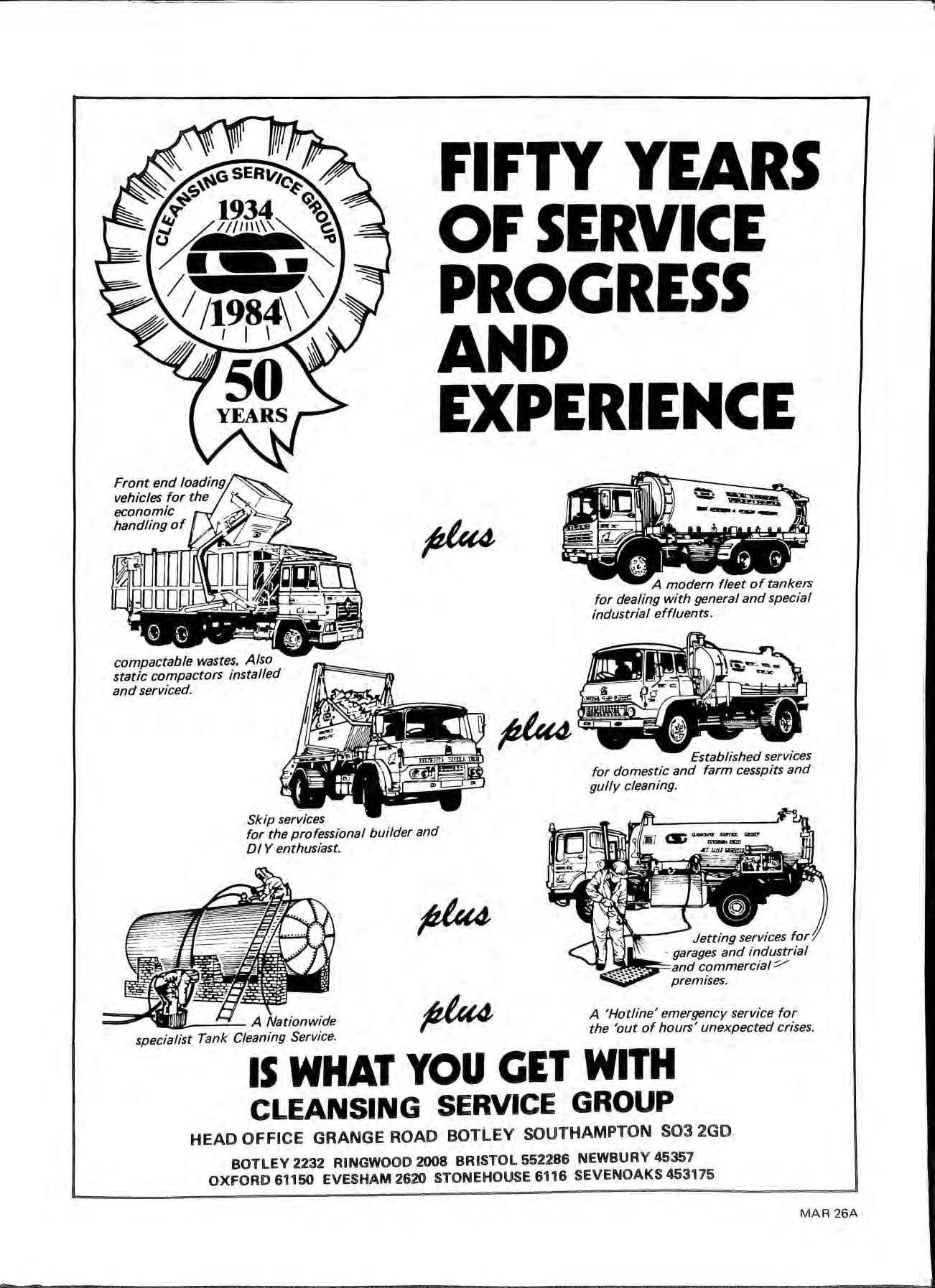
compactable wastes. Also static compactors installed and serviced. FIFTY YEARS OF SERVICE PROGRESS AND EXPERIENCE A modern fleet of tankers for dealing with general and special industrial effluents Established services for domestic and farm cesspits and gully cleaning Skip services for the professional builder and DI Y enthusiast. A Nationwide specialist Tank Cleaning Service. p"'4 Jetting services for garages and industrial commercial ::;--premises. A 'Hotline' emergency service for the 'ou t of hours ' unexpected c r ises IS WHAT YOU CiET WITH CLEANSING SERVICE GROUP HEAD O FFIC E GRANGE ROAD BOTL EY SOUTHAMPTON S03 2GD BOTLEY 2232 RIN GWOOD 2008 BR ISTOL 552286 NEWBURY 45357 OXFORD 61150 EVESHAM 2620 STON EHOUSE 6116 SEVENOAKS 453175 MA R 26 A
During the past 2 years a different type of drive belt has appeared on forecourt petrol dispensers. The name is Tab-Link, and its unique polyester/polyurethane construction enables this belt to last a minimum of six times longer than conventional V-belts. It' s easier to service, as one reel enables the service engineer to make up any length of belt to suit all pump assemblies, thereby greatly reducing the stock carried
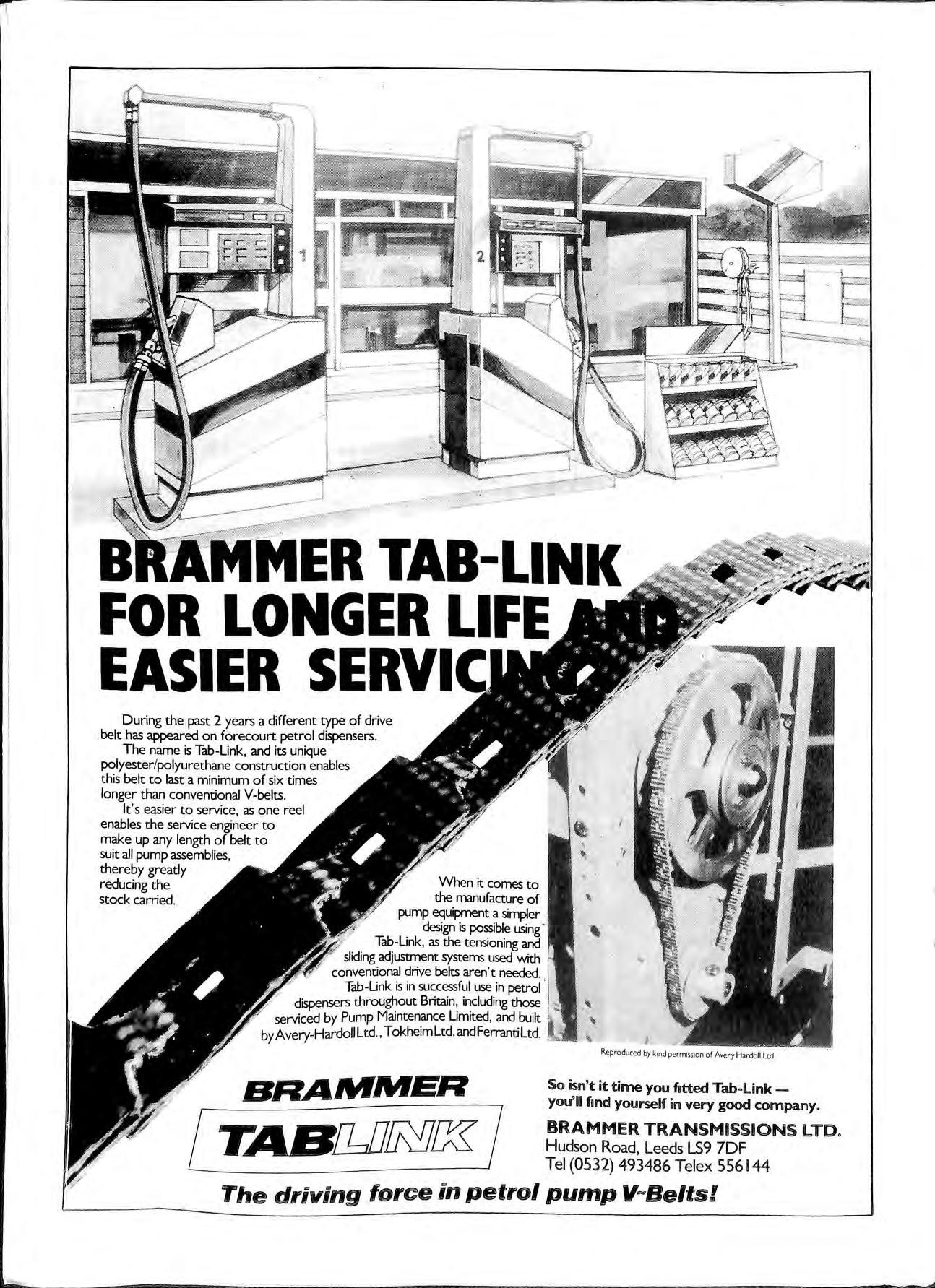
When it comes to the manufacture of
pump equipment a simpler
design is possible using· Tab-Link, as the tensioning and sliding adjustment systems used with
onventional drive belts aren't needed ,i
Tab-Link is in use in petrol
dispensers throughout Bntam'. those
•"'
"
v
,.
I , •
1 ·;r r' serviced
· byAvery-HardollLtd.
BRA/tllltllER So isn't it time you fitted Tab Link you'll fmd yourself in very good company BRAMMER TRANSMISSIONS LTD . Hudson Road , Leeds LS9 7DF Tel (05 32) 493486 Telex 556 144 The driving force in petrol pump V=Belts!
by Pump Maintenance Limited, and built
, TokheimLtd.andFerrantiLtd
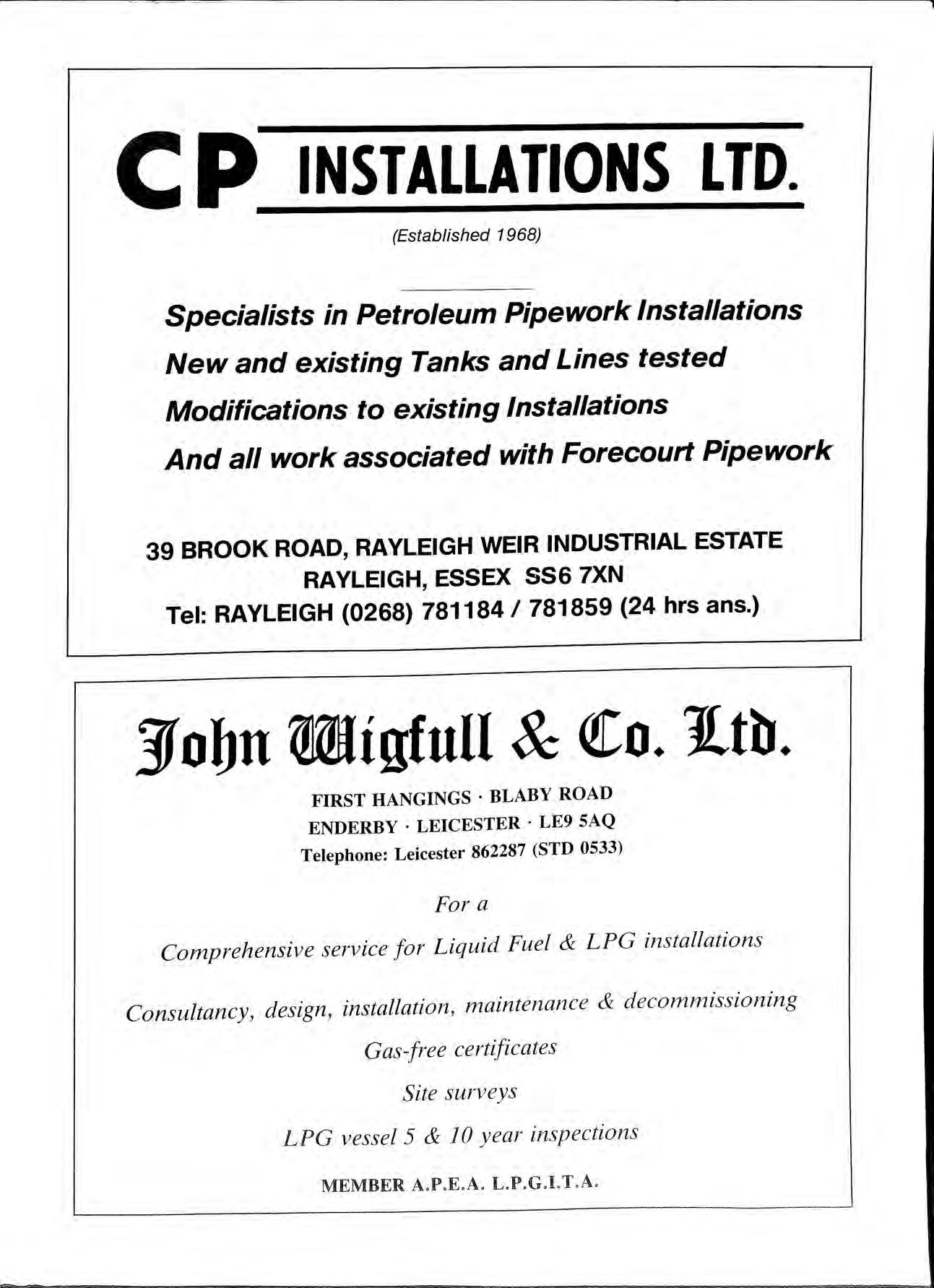
C p INSTALLATIONS LTD. (Established 1968) Specialists in Petroleum Pipework Installations New and existing Tanks and Lines tested Modifications to existing Installations And all work associated with Forecourt Pipework 39 BROOK ROAD, RAYLEIGH WEIR INDUSTRIAL ESTATE RAYLEIGH, ESSEX SS6 7XN Tel: RAYLEIGH (0268) 781184 I 781859 (24 hrs ans.) J obn ull & QCo. 1Ltb. FIRST H ANGINGS · BLABY ROAD ENDERBY · LEICESTER · LE9 SAQ Telephone: Leicester 862287 (STD 0533 ) For a Comp re h e nsi ve serv ic e f or Liq u id F ue l & LPG insta ll ations C o nsulta n cy, desi g n , installation, m ai n ten an ce & decomm issioning Gas-free certificate s Site surveys LPG vessel 5 & 1 0 year inspe c tions MEMBER A.P.E.A. L.P.G.I.T A
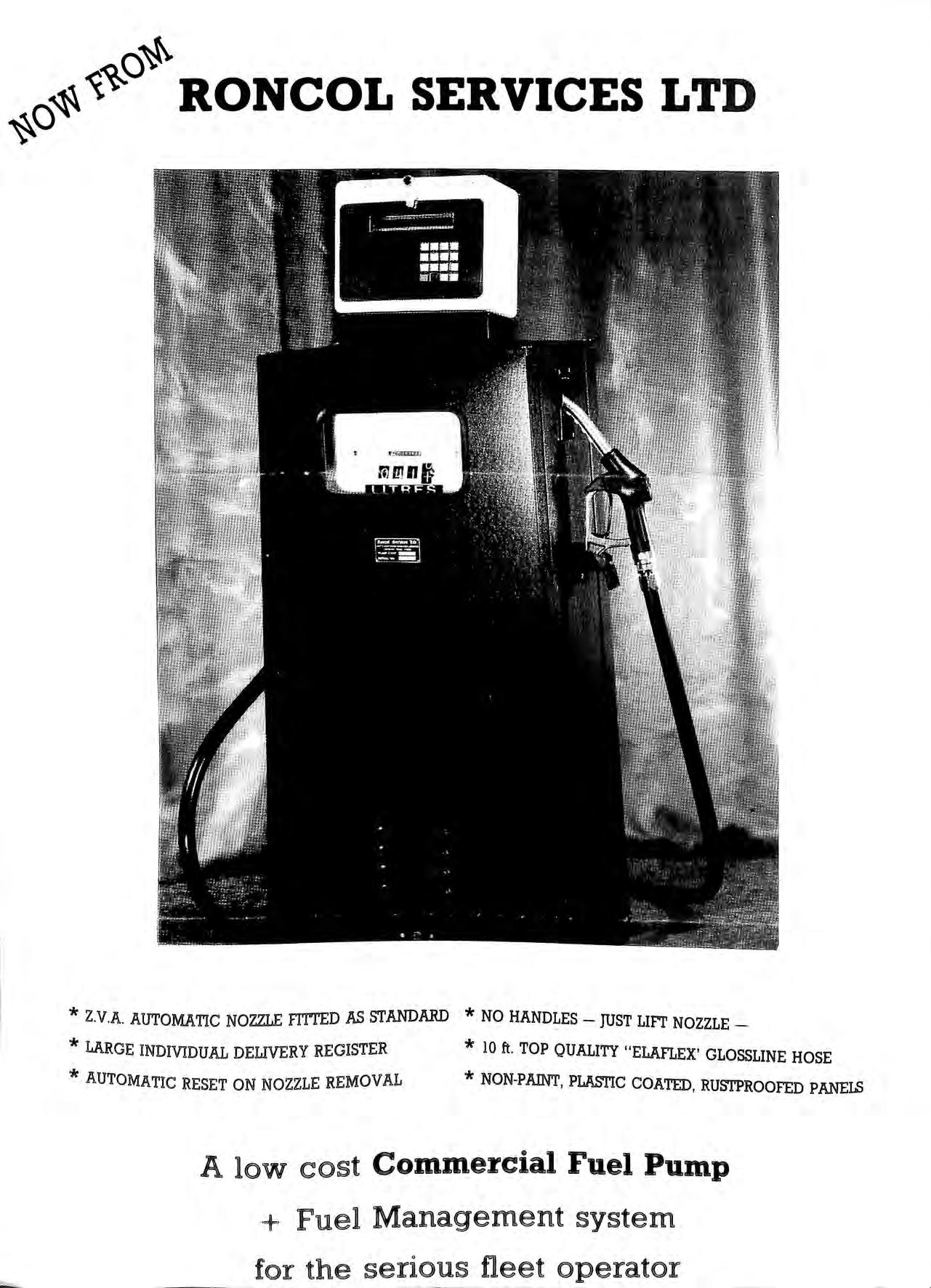
RONCOL SERVICES LTD * Z.V.A. AUTOMATIC NOZZLE FITI'ED AS STANDARD *NO HANDLES JUST LIFT NOZZLE * LARGE INDIVIDUAL DELIVERY REGISTER *AUTOMATIC RESET ON NOZZLE REMOVAL * 10 ft. TOP QUALITY "ELAFLEX' GLOSSLINE HOSE * NON PAINT, PLASTIC COATED, RUSTPROOFED PANELS A low cost Commercial Fuel Pump + Fuel Management system for the serious fleet operator
THE RONCOL COMMERCIAL FUEL PUMP
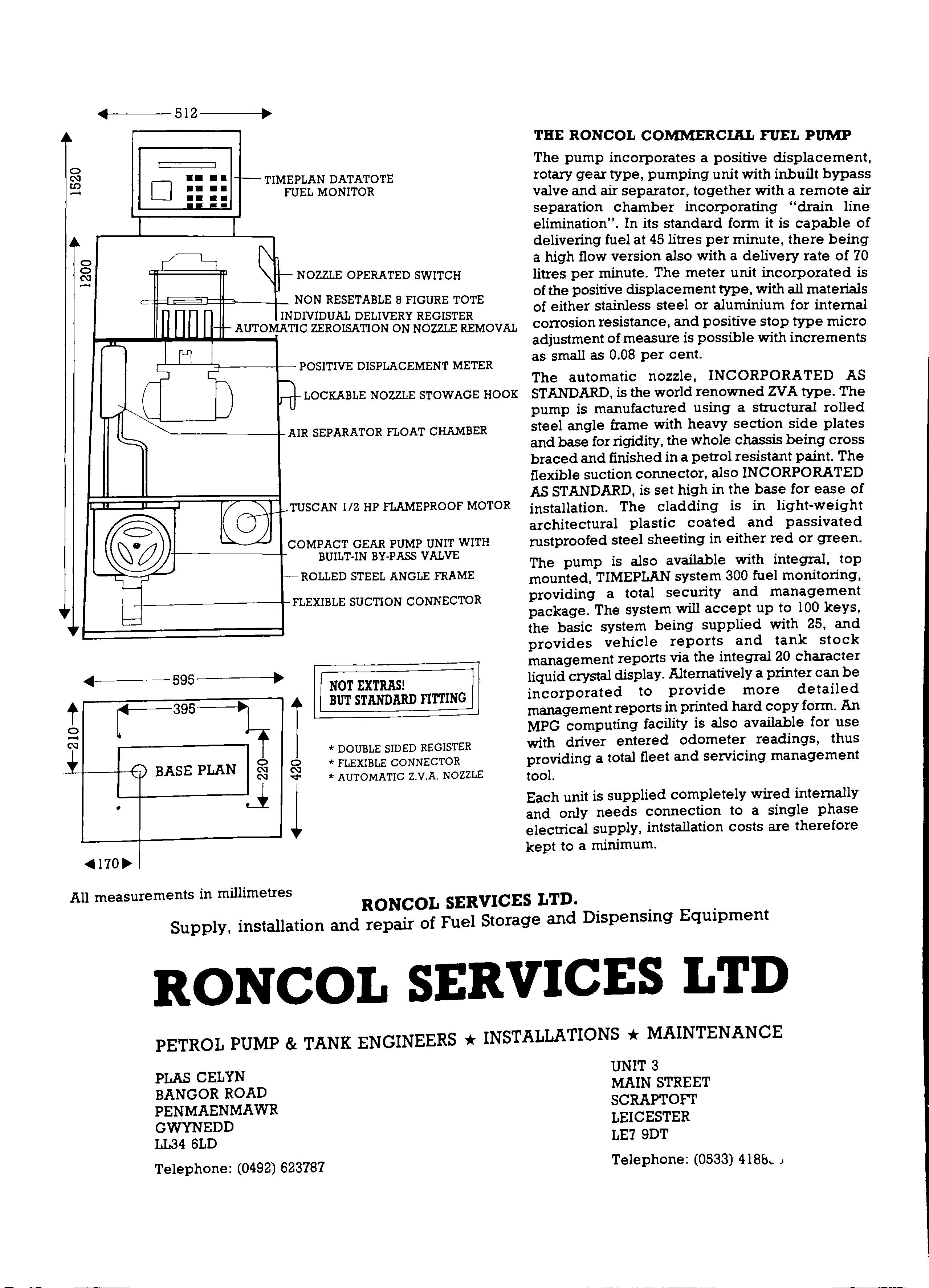
The pump incorporates a positive displacement, rotary gear type, pumping unit with inbuilt bypass valve and air separator, together with a remote air separation chamber incorporating "drain line elimination". In its standard form it is capable of delivering fuel at 45 litres per minute, there being a high Dow version also with a delivery rate of 70 litres. per minute. The meter unit incorporated is of the positive displacement type, with all materials of either stainless steel or aluminium for internal corrosion resistance, and positive stop type micro adjustment of measure is possible with increments as small as 0.08 per cent.
The automatic nozzle, INCORPORATED AS STANDARD, is the world renowned ZVA type. The pump is manufactured using a structural rolled steel angle frame with heavy section side plates and base for rigidity, the whole chassis being cross braced and finished in a petrol resistant paint. The flexible suction connector, also INCORPORATED AS STANDARD, is set high in the base for ease of installation. The cladding is in light-weight architectural plastic coated and passivated rustproofed steel sheeting in either red or green.
The pump is also available with integral, top mounted, TIMEPLAN system 300 fuel monitoring, providing a total security and management package. The system will accept up to 100 keys, the basic system being supplied with 25, and provides vehicle reports and tank stock management reports via the integral 20 character liquid crystal display. Alternatively a printer can be incorporated to provide more detailed management reports in printed hard copy form. An MPG computing facility is also available for use with driver entered odometer readings, thus providing a total fleet and servicing management tool.
0 N U)0 0 N•'<111---512---·· 0 •••• •••• •••• • TIMEPLAN DATATOTE FUEL MONITOR NOZZLE OPERATED SWITCH 9ji::::U~~=#=~---t.NON RESETABLE 8 FIGURE TOTE INDMDUAL DELIVERY REGISTER AUTOMATIC ZEROISATION ON NOZZLE REMOVAL l"""ln---........................____-1 LOCKABLE NOZZLE STOWAGE HOOK COMPACT GEAR PUMP UNIT WITH J-t--------1- BUILT-IN BY-PASS VALVE ROLLED STEEL ANGLE FRAME -1---------t-FLEXIBLE SUCTION CONNECTOR
1---~595----~· NOT EXTRAS!
t 0N r--395~ i BASE PLAN g g N "<t' l BUT STANDARD nmNG * DOUBLE SIDED REGISTER * FLEXIBLE CONNECTOR *AUTOMATIC Z.V.A. NOZZLE
unit
minimum . All measurements in millimetres RONCOL SERVICES LTD. Supply, installation and repair of Fuel Storage and Dispensing Equipment RONCOL SERVICES LTD PETROL PUMP & TANK ENGINEERS* INSTALLATIONS* MAINTENANCE PLAS CELYN BANGOR ROAD PENMAENMAWR GWYNEDD LL34 6LD Telephone: (0492) 623787 UNIT 3 MAIN STREET SCRAPTOFT LEICESTER LE7 9DT Telephone: (0533) 418b ,
Each
is supplied completely wired internally and only needs connection to a single phase electrical supply, intstallation costs are therefore kept to a
19 PLASHET GROVE, LONDON. E6 1AD
Telephone: 01-472 6627/8

Aden con Draughting Services Ltd.
Specialists in the preparation of drawings for petrol filling service station redevelopments, alterations and tank or equipment installations and obtaining all necessary statutory authority approvals (i.e. planning permission, building regulation approval, petroleum officer approval etc.) MEMBER A.P.E.A. PHONE 01-739 9538 TUBEFLOW LTD and SOUTHERN PUMP SERVICES "WE COVER LONDON" CONTRACTORS TO THE PETROLEUM INDUSTRY AND LOCAL GOVERNMENT AUTHORITIES SUPPLY, INSTALLATION AND MAINTENANCE OF FUEL PUMPS, TANKS AND EQUiPMENT PIPEWORK INSTALLATIONS. ETC. 27=29 TEMPLE STREET, LONDON E2 6QQ
LAFON SAFETY FILLING LIMITERS
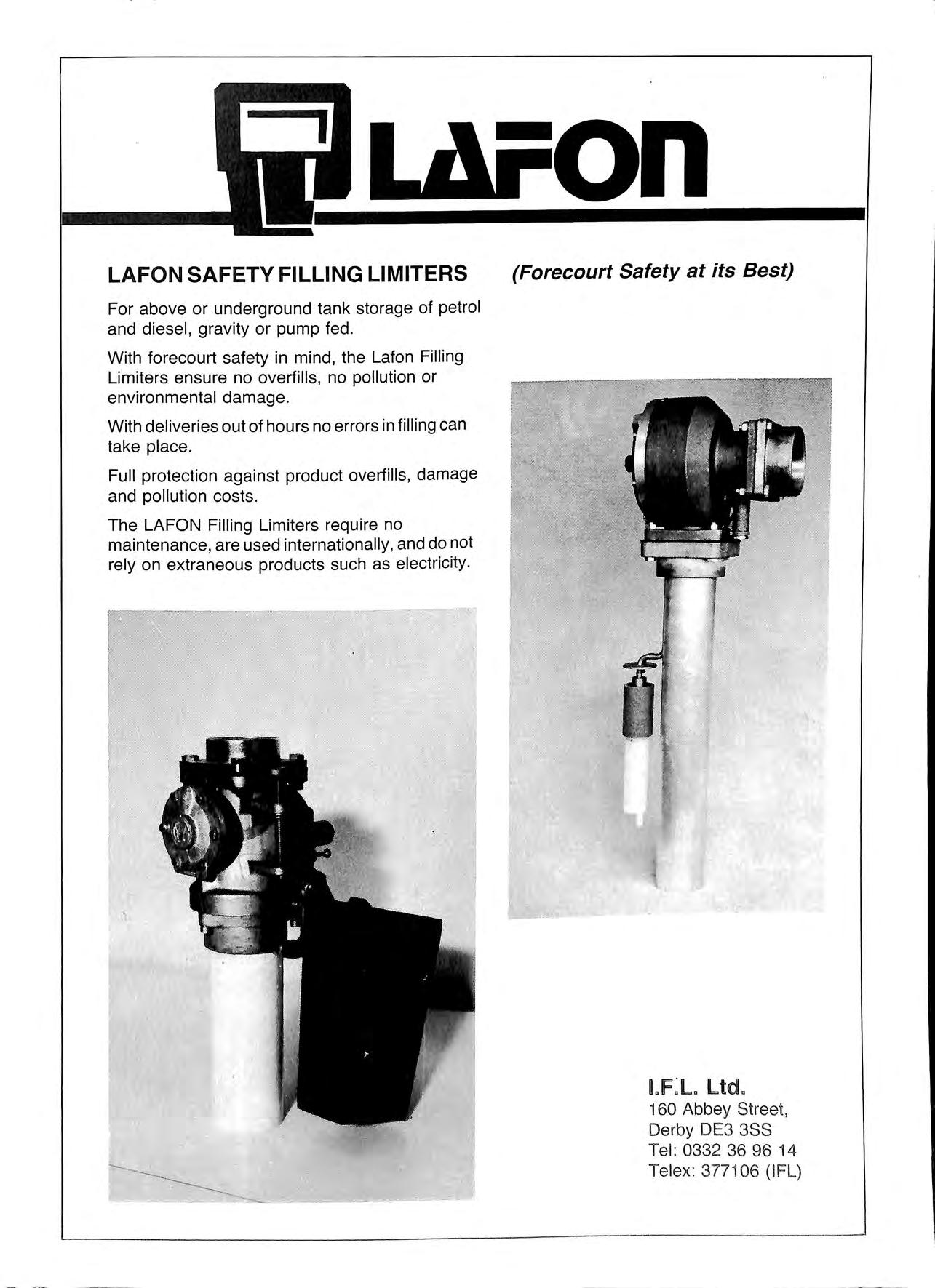
For above or underground tank storage of petrol and diesel, gravity or pump fed.
With forecourt safety in mind, the Lafon Filling Limiters ensure no overfills, no pollution or environmental damage.
With deliveries out of hours no errors in filling can take place.
Full protection against product overfills, damage and pollution costs.
The LAFON Filling Limiters require no maintenance, are used internationally, and do not rely on extraneous products such as electricity.
-on
Ltd.
160 Abbey Street, Derby DE3 3SS
Tel: 0332 36 96 14
Telex : 377106 (IFL)
(Forecourt Safety at its Best)
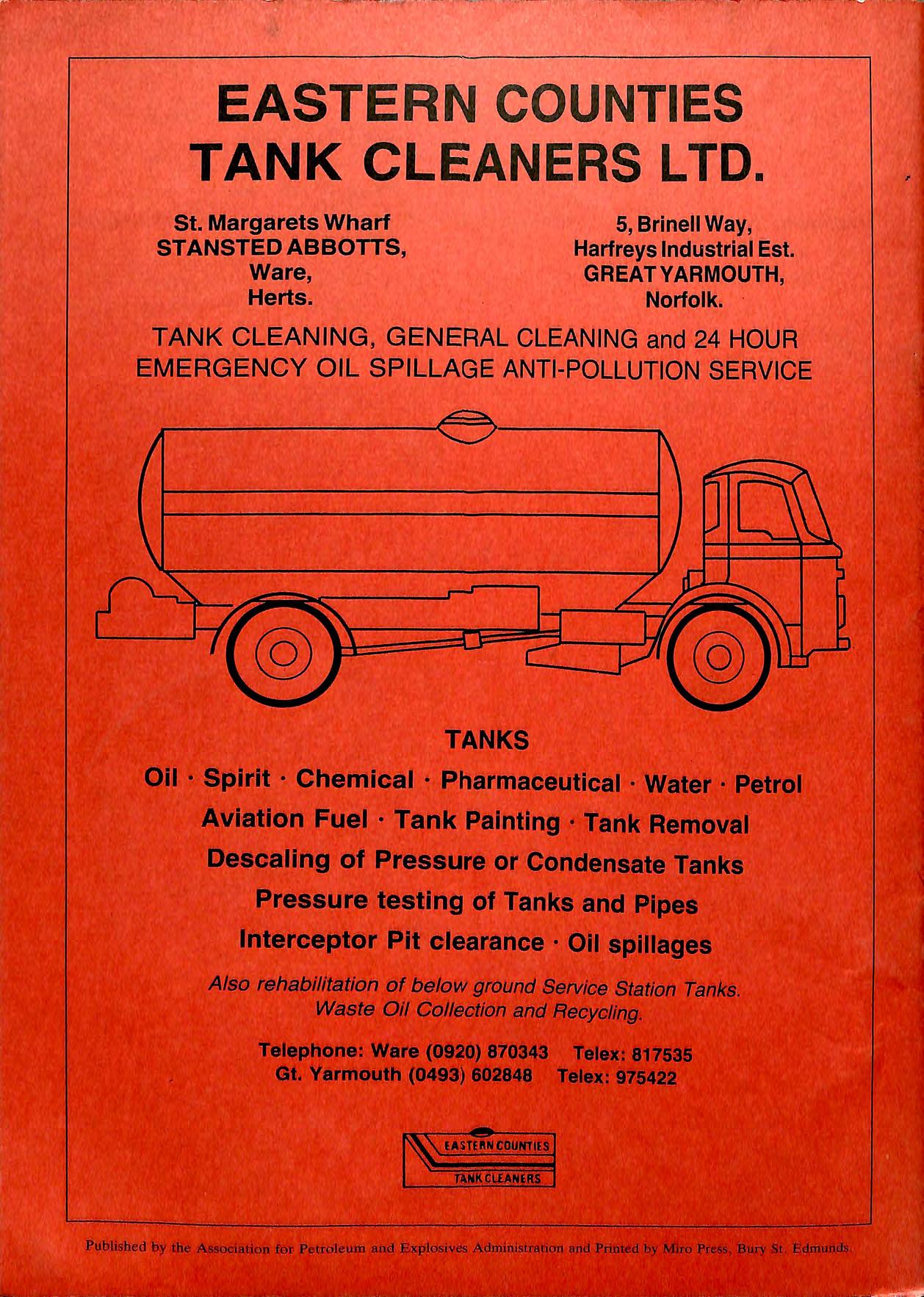
EASTERN COUNTIES TANK CLEANERS l TD. St. Margarets Wharf STANSTED ABBOTTS, Ware, Herts. 5, Brinell Way, Harfreys Industrial list. GREAT YARMOUTH, Norfolk. · TANK CLEANING, GENERAL CLEANING and 24 HOUR EMERGENCY 0 1IL SPILLAGE ANTI-POLLUTION SERVICE TAN1KS Oil • Spirit · Chem1ica.I • Pharmaceutical · Water · Petrol Aviation Fuel · Tank Painting · Tiank Removal Descaling of Pressure or Condensate Tanks Pressure testing of Ta1nks a1nd Pi1pes l 1nte'rce,pto,ri Pit cl.earance • 0 .111spiiUages Also rehabilitation of below ground Service Station Tanks . Waste Oil Collection and Recycling. Telephone: Ware (0920) 870343 Telex: 81763!; Gt. Yarmout h (0493) 602848 Telex : 915422 ,.




























